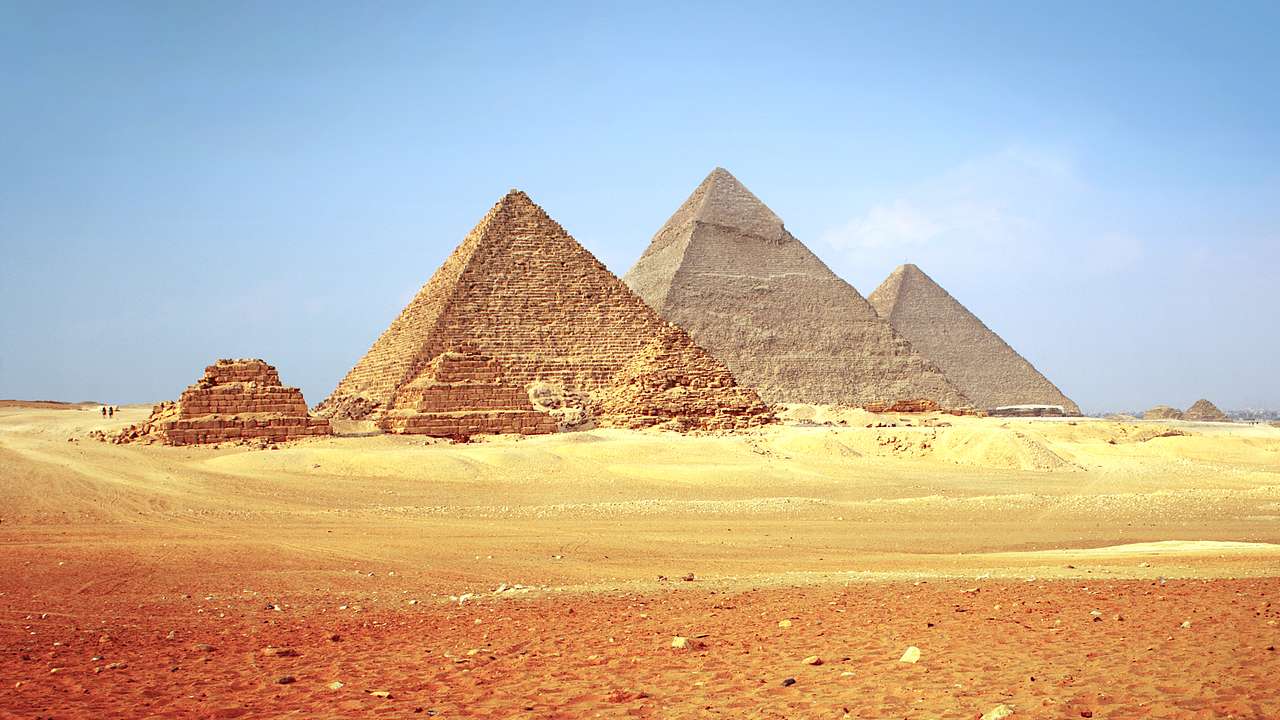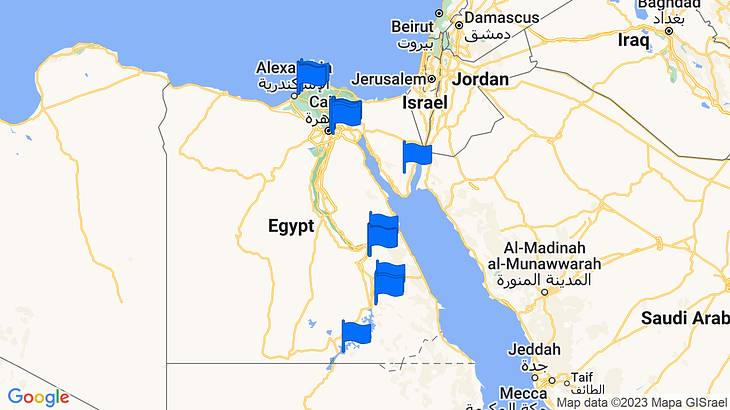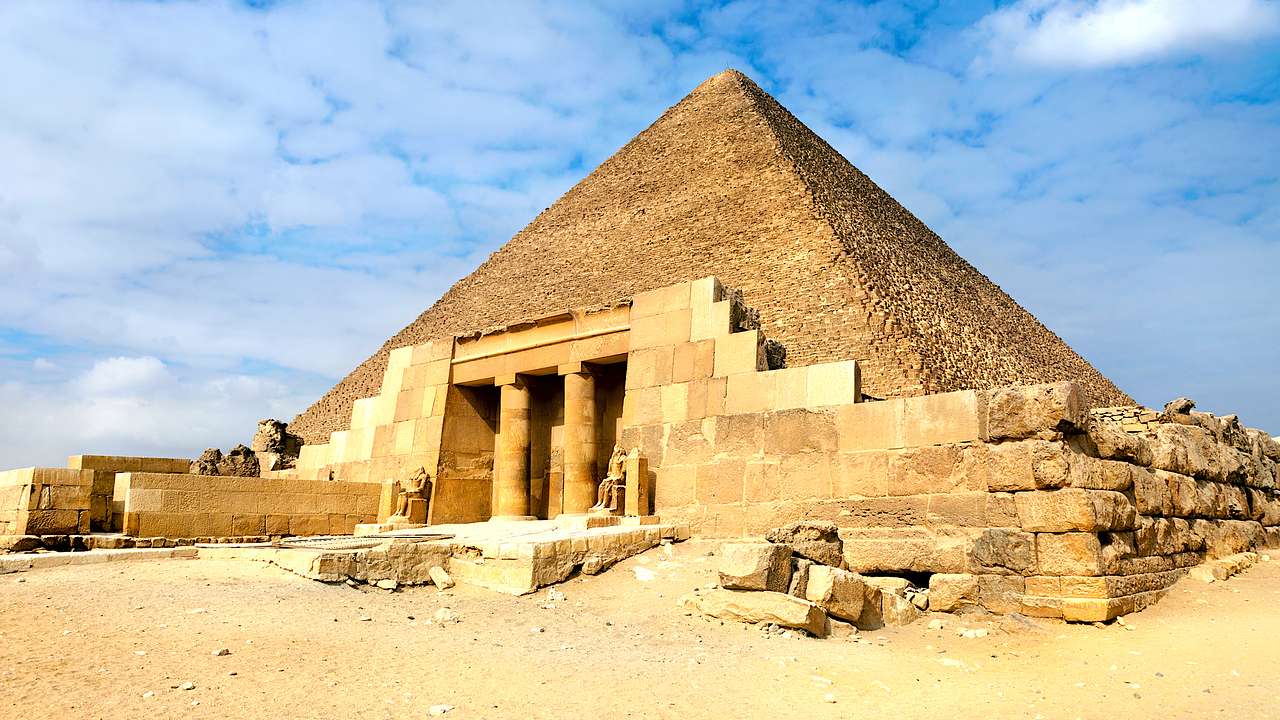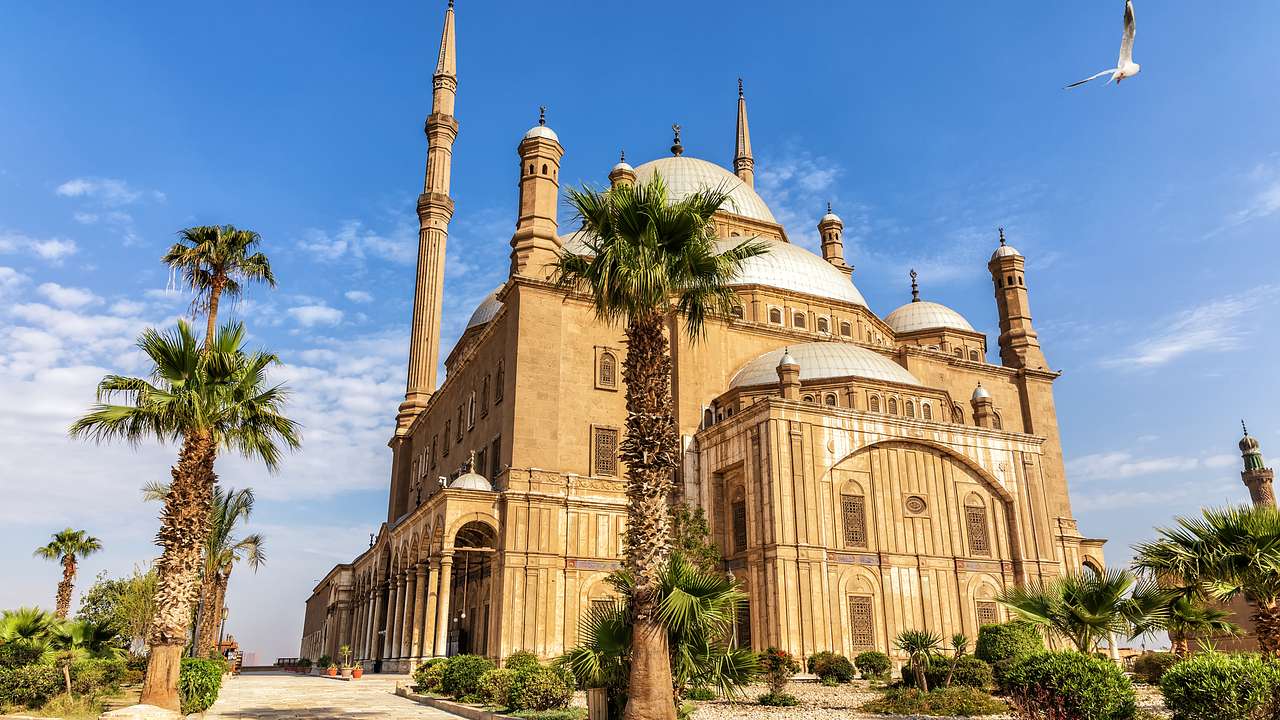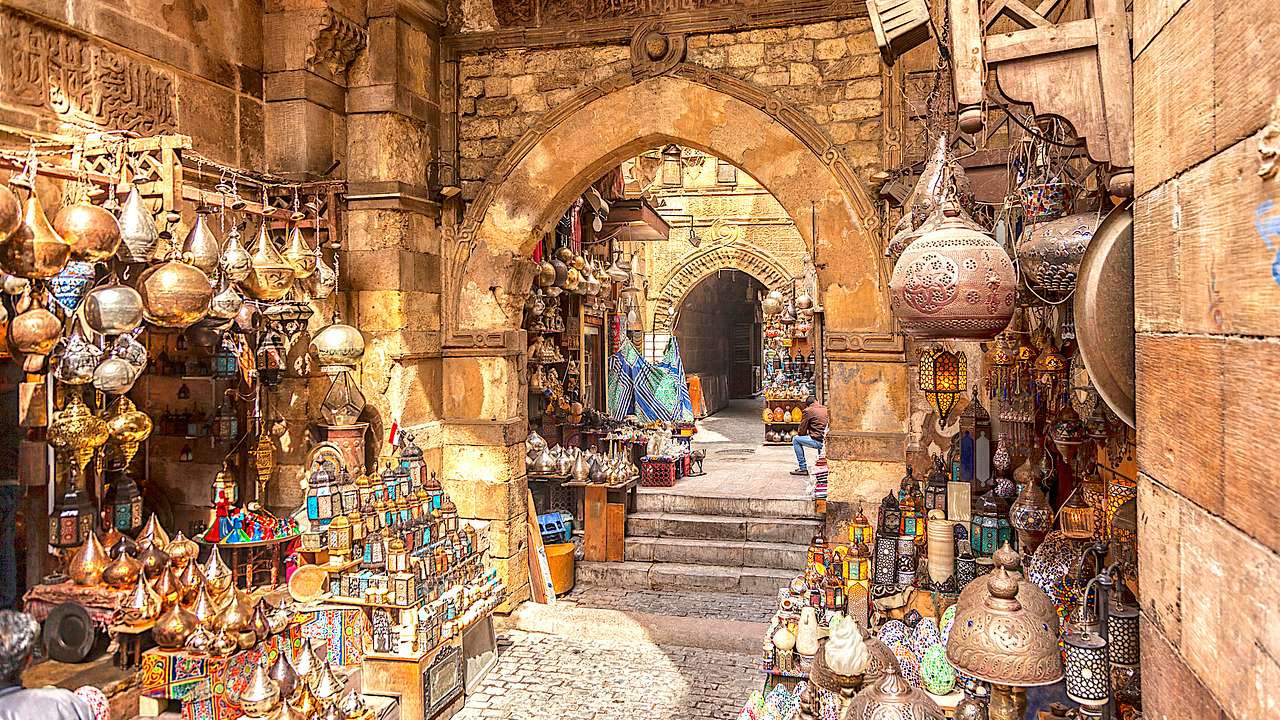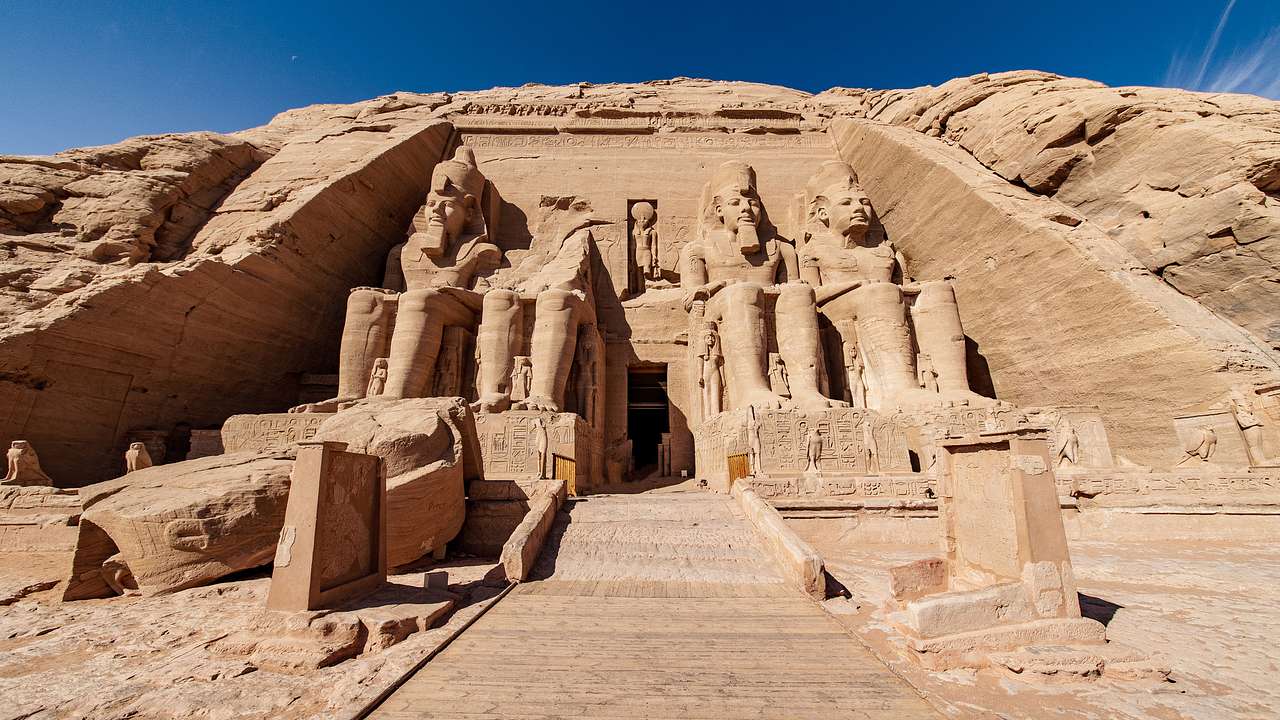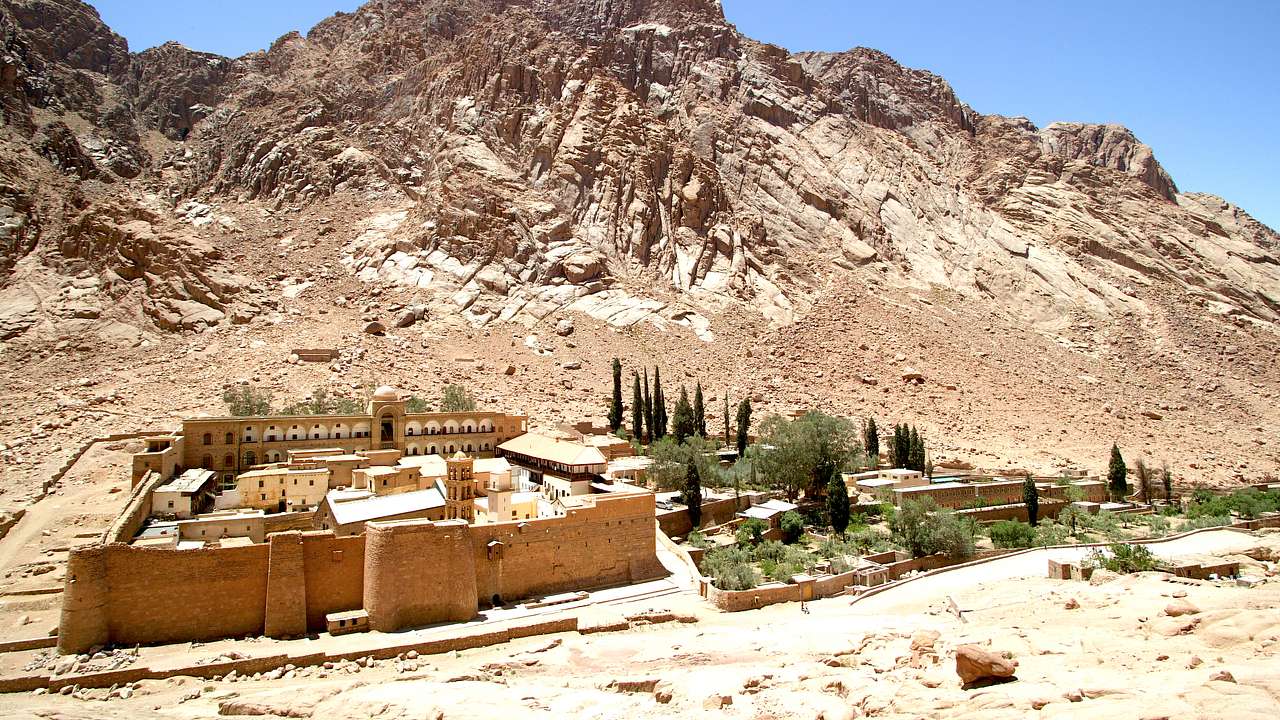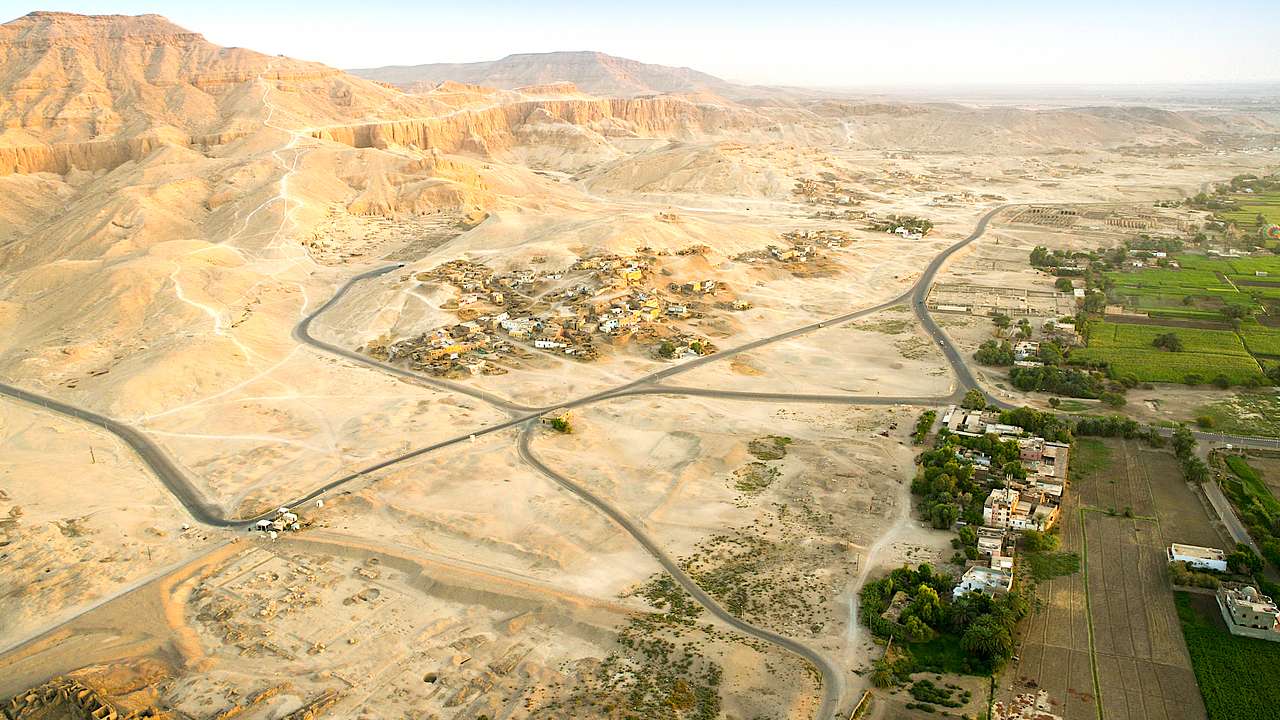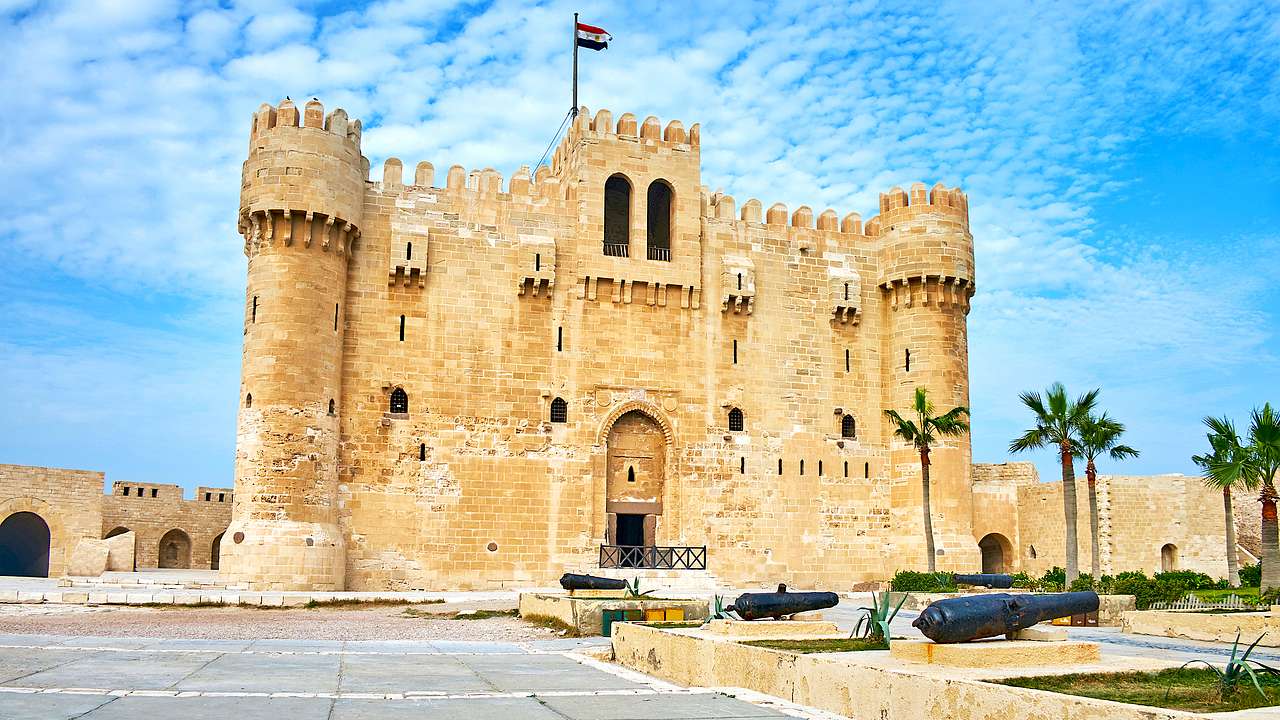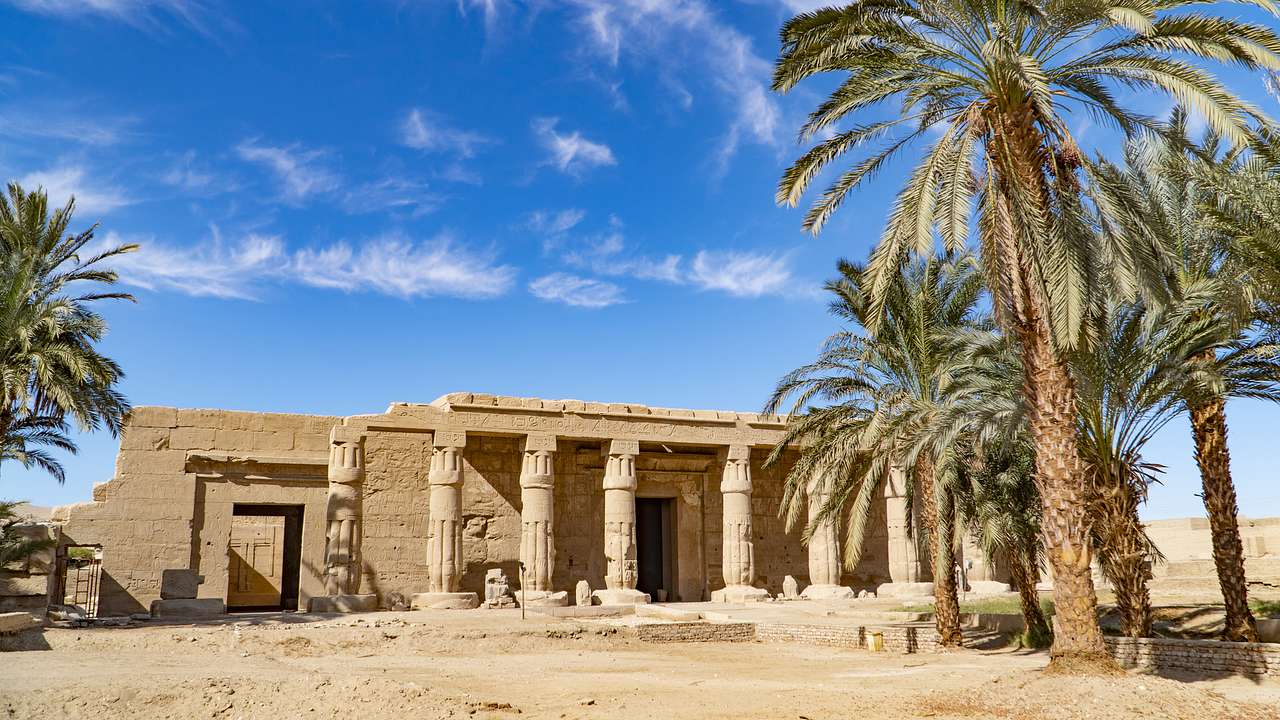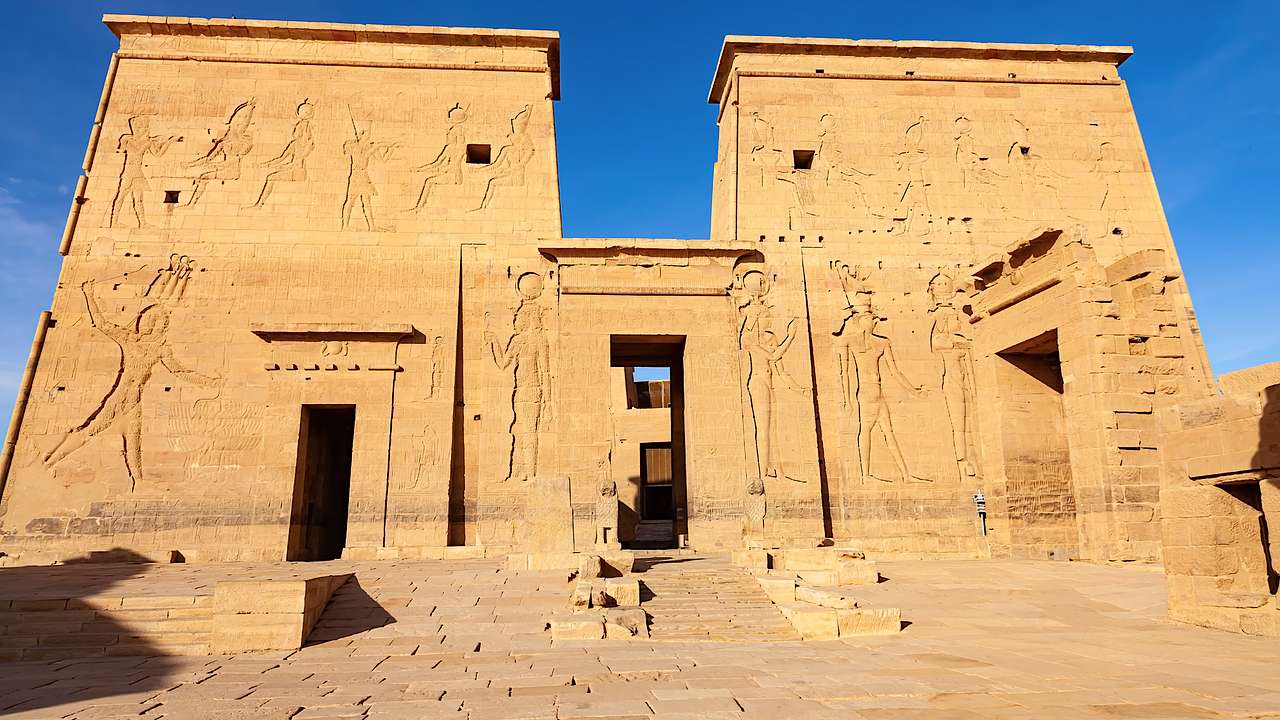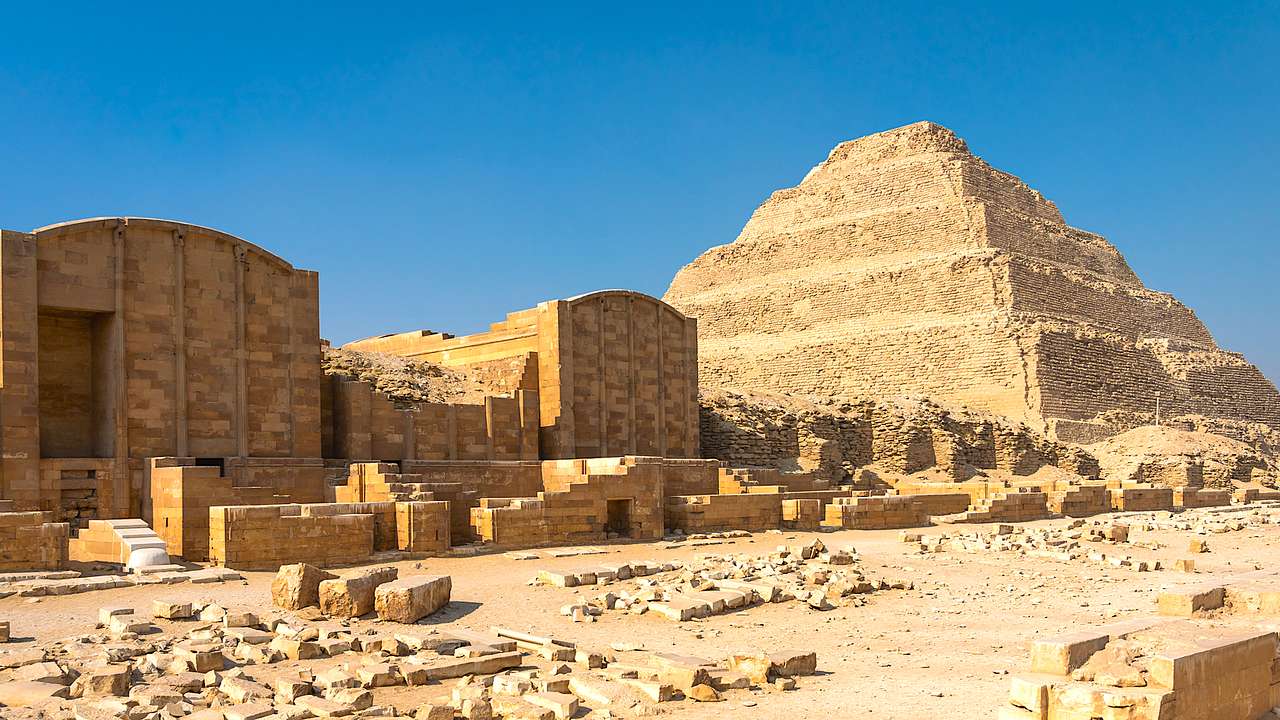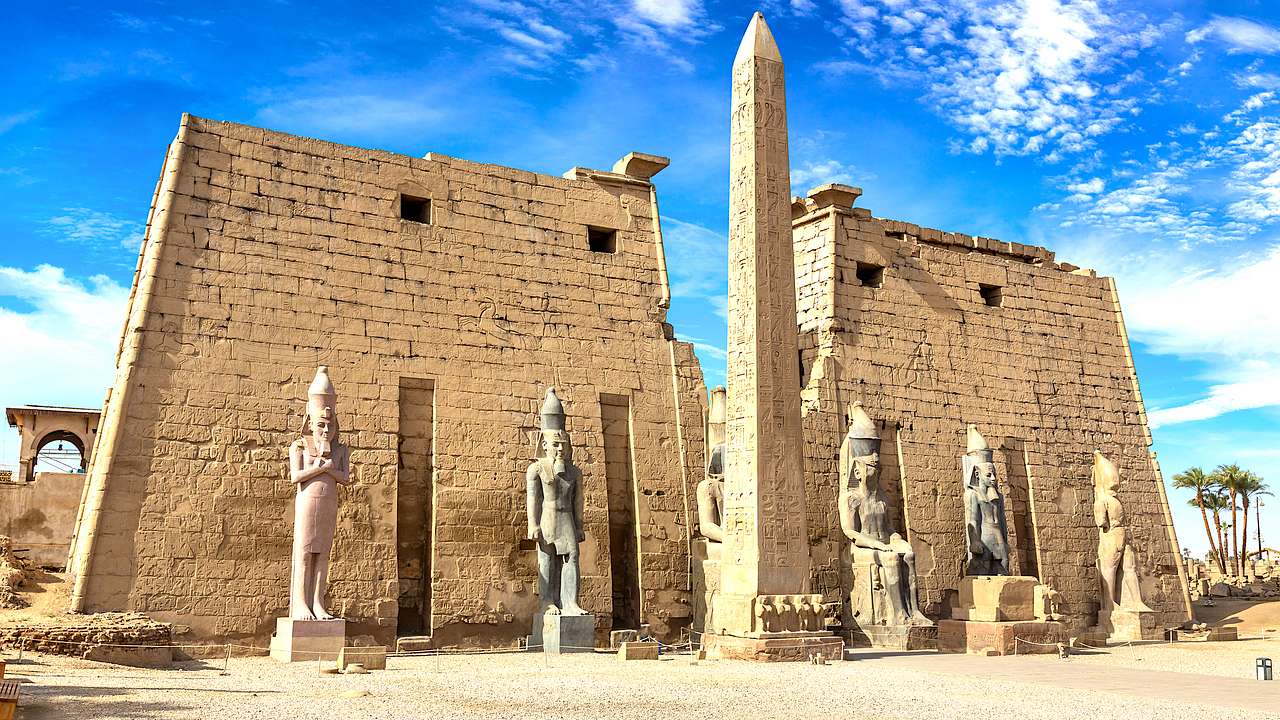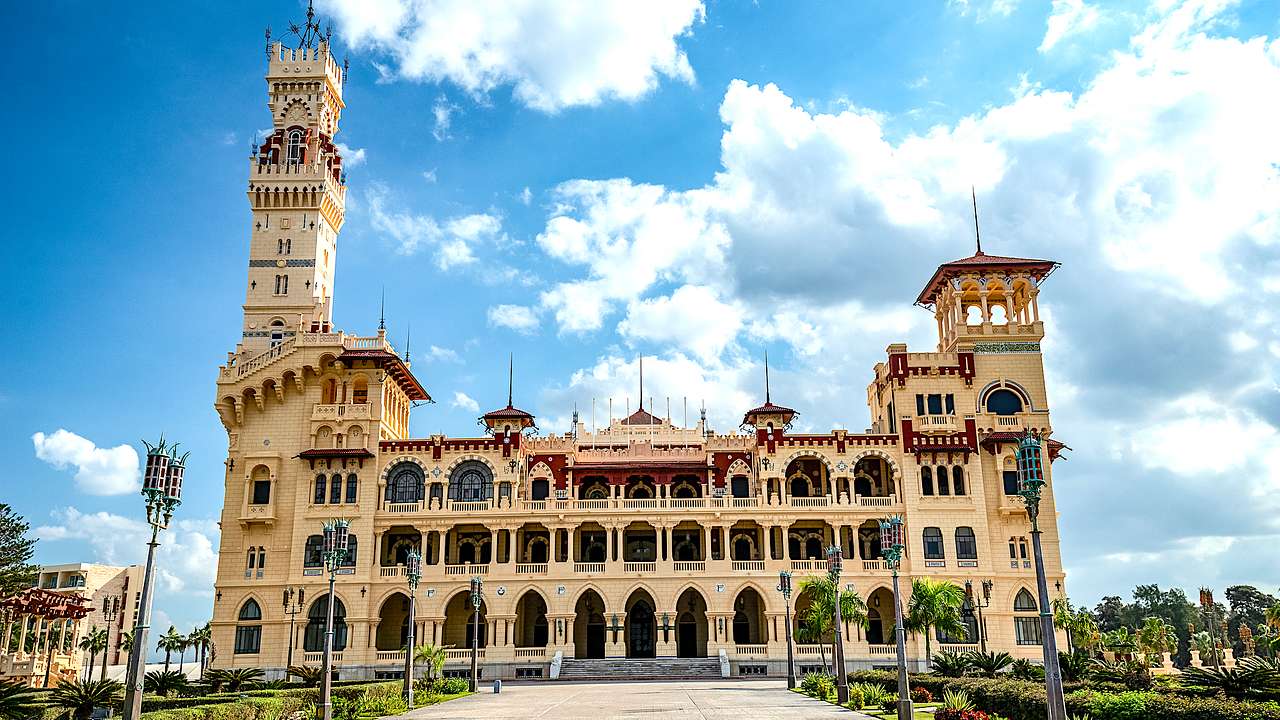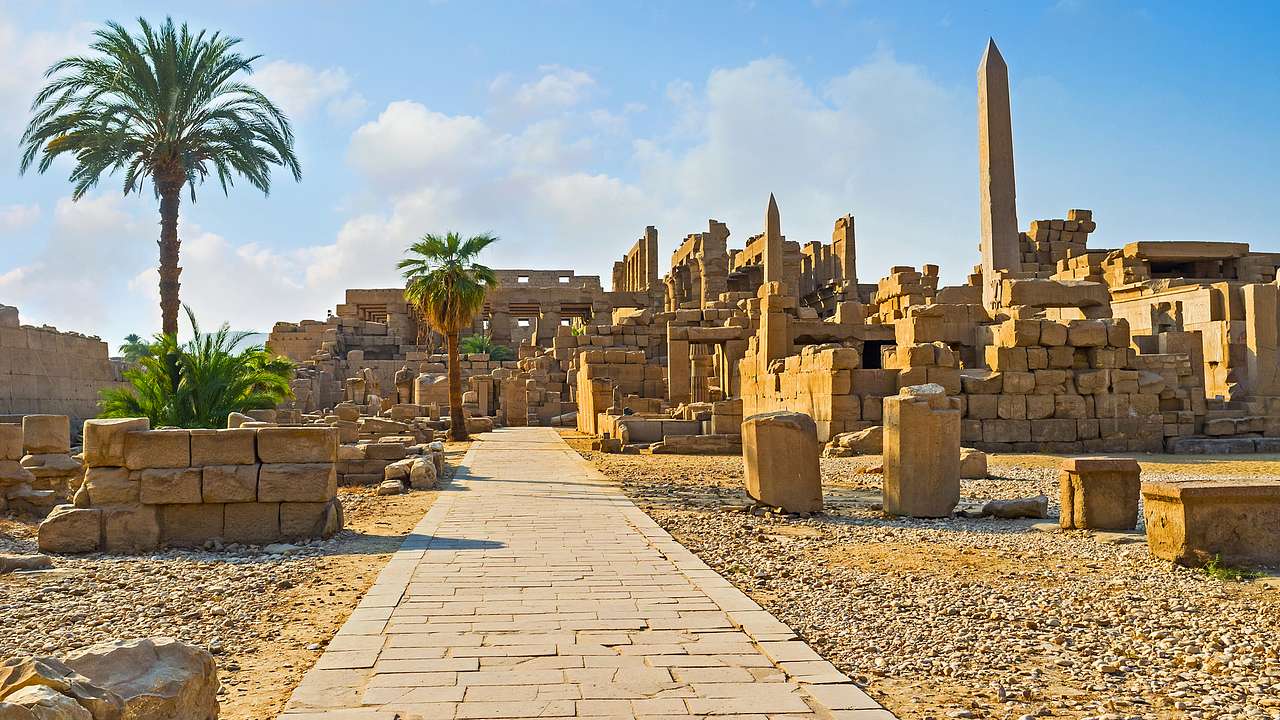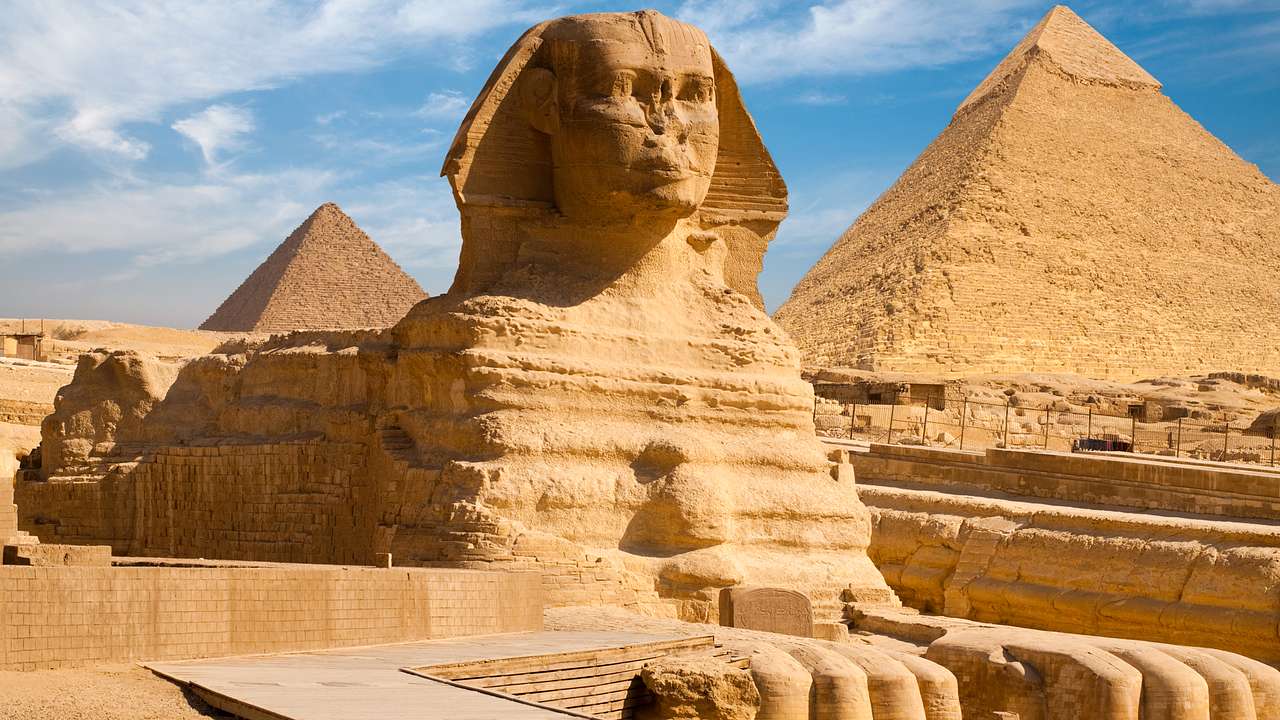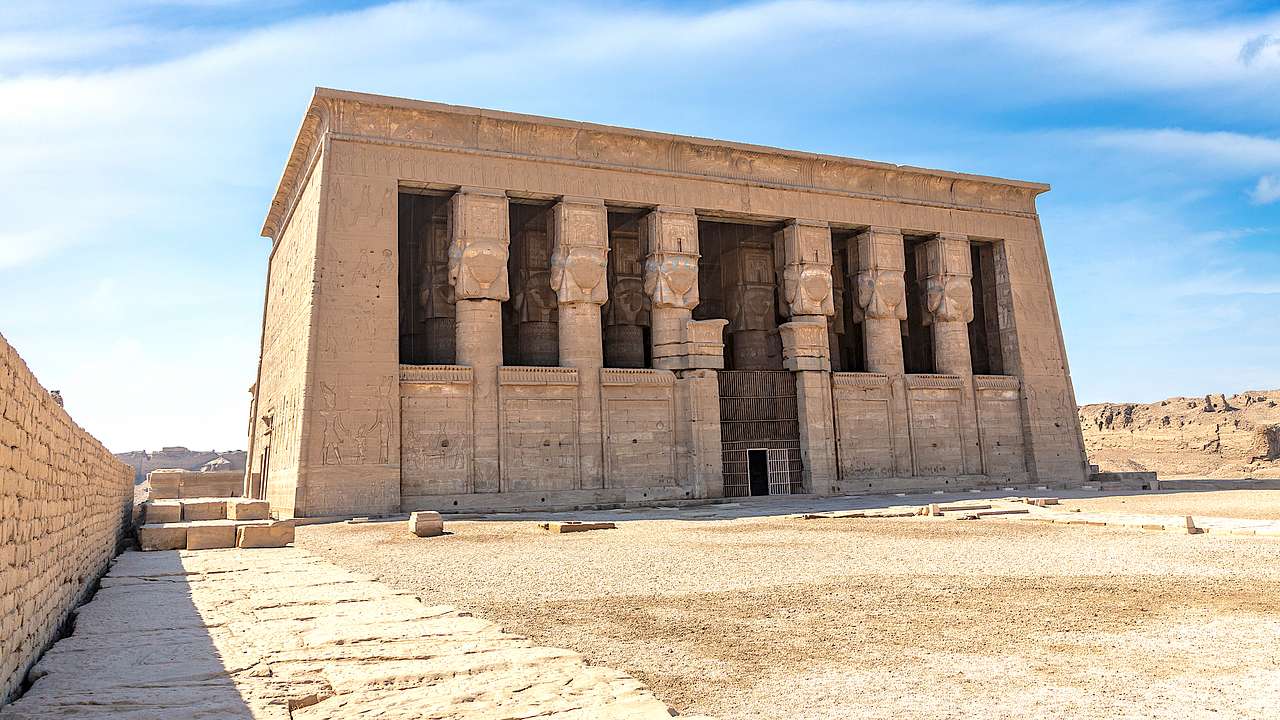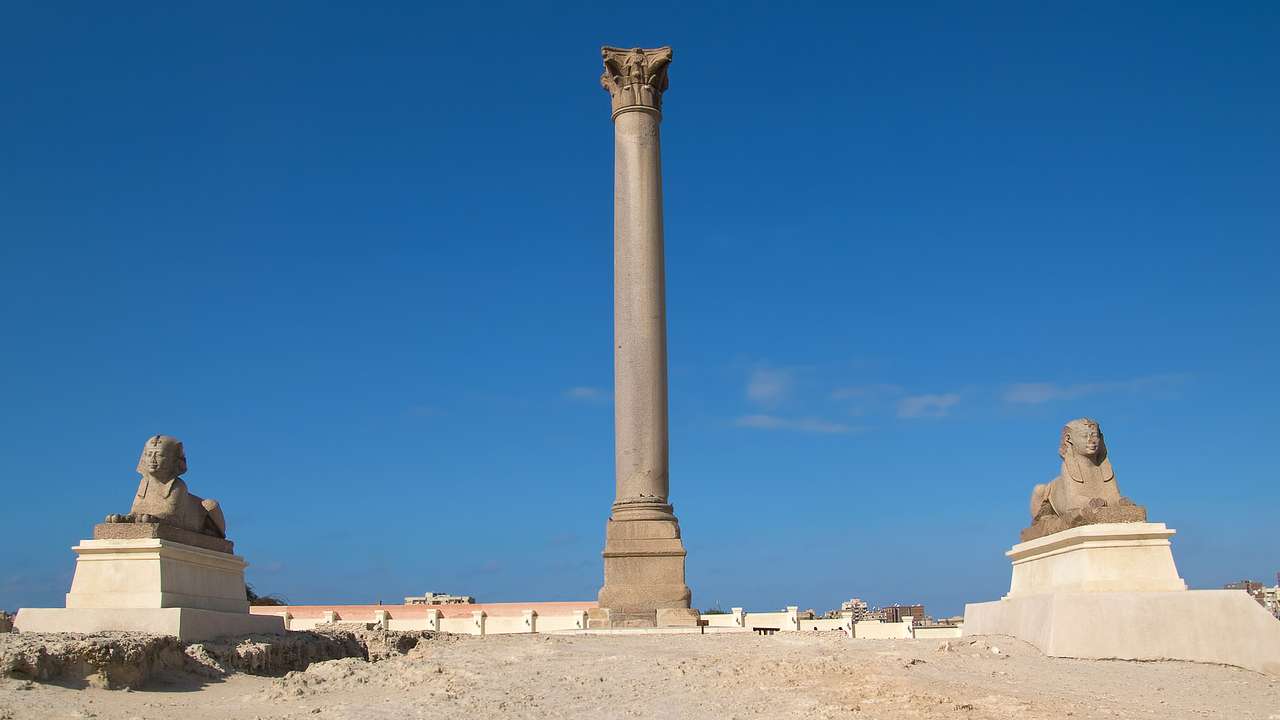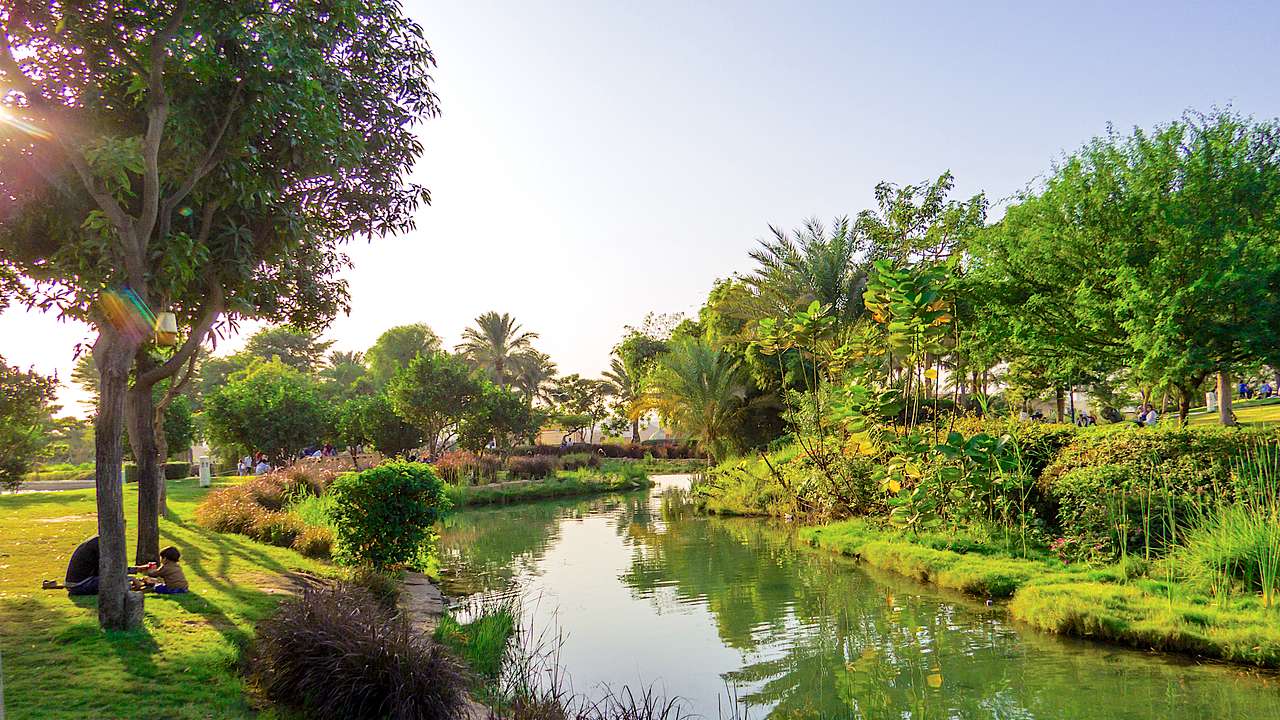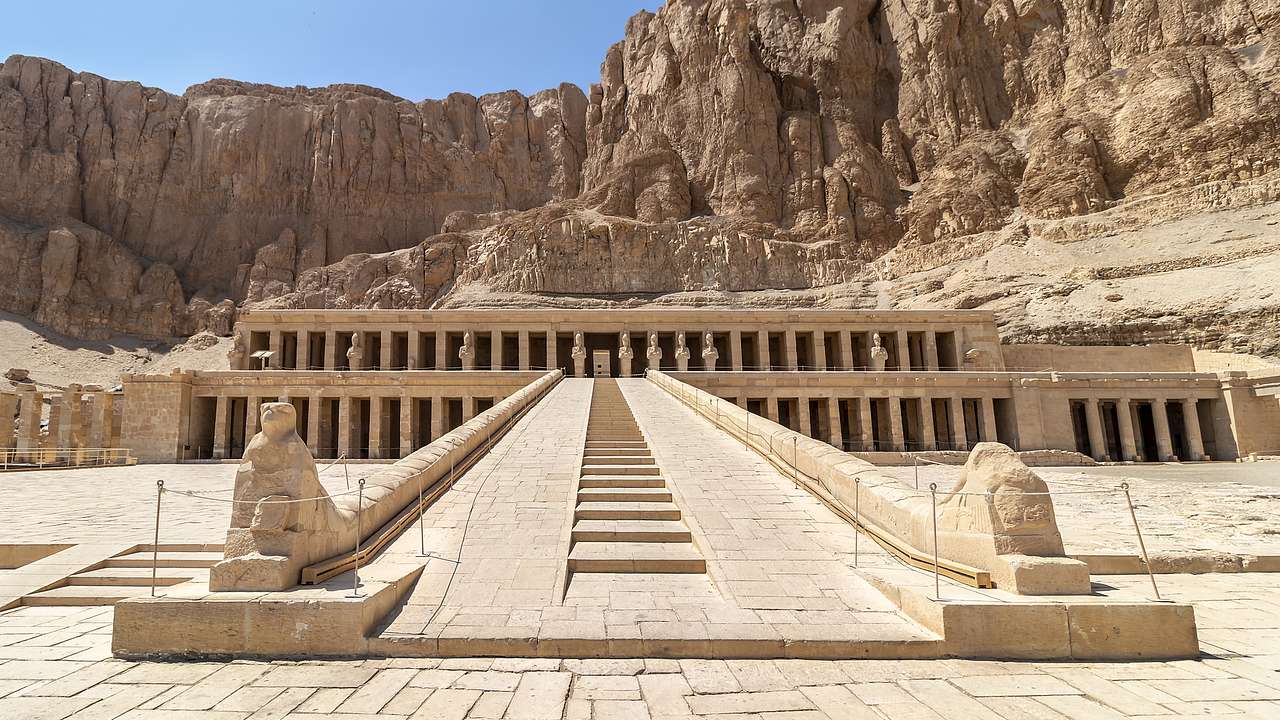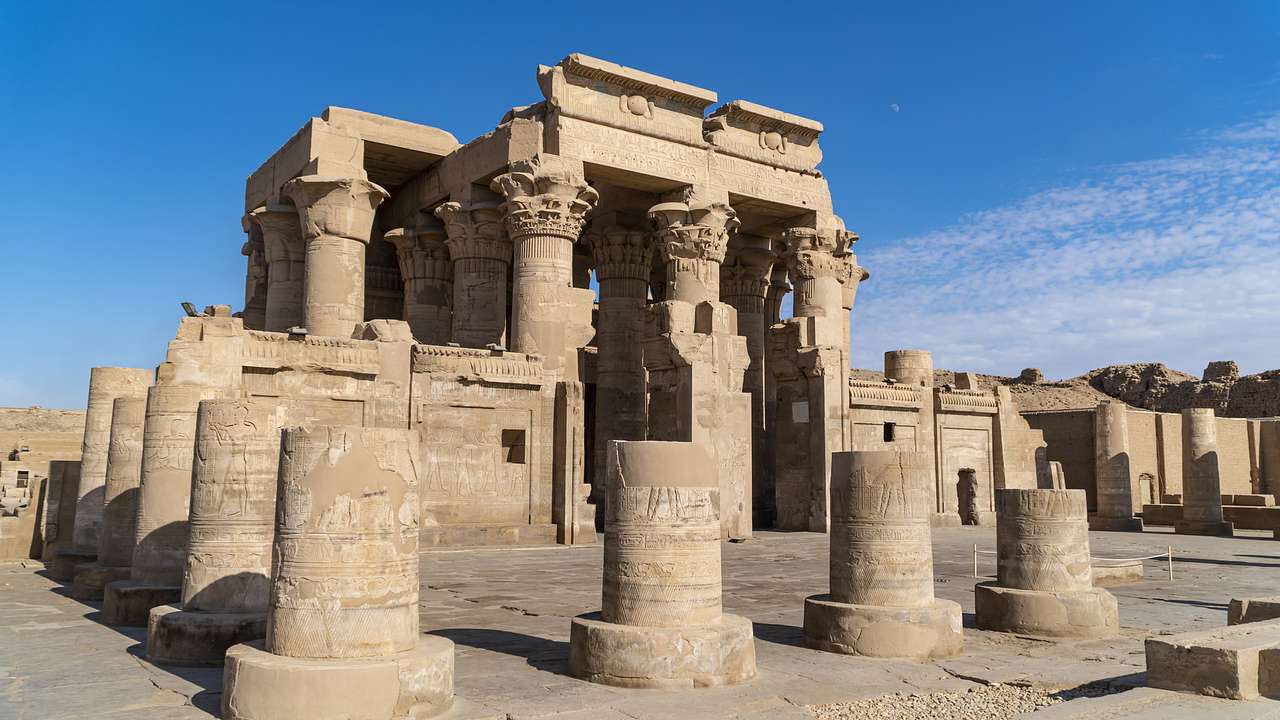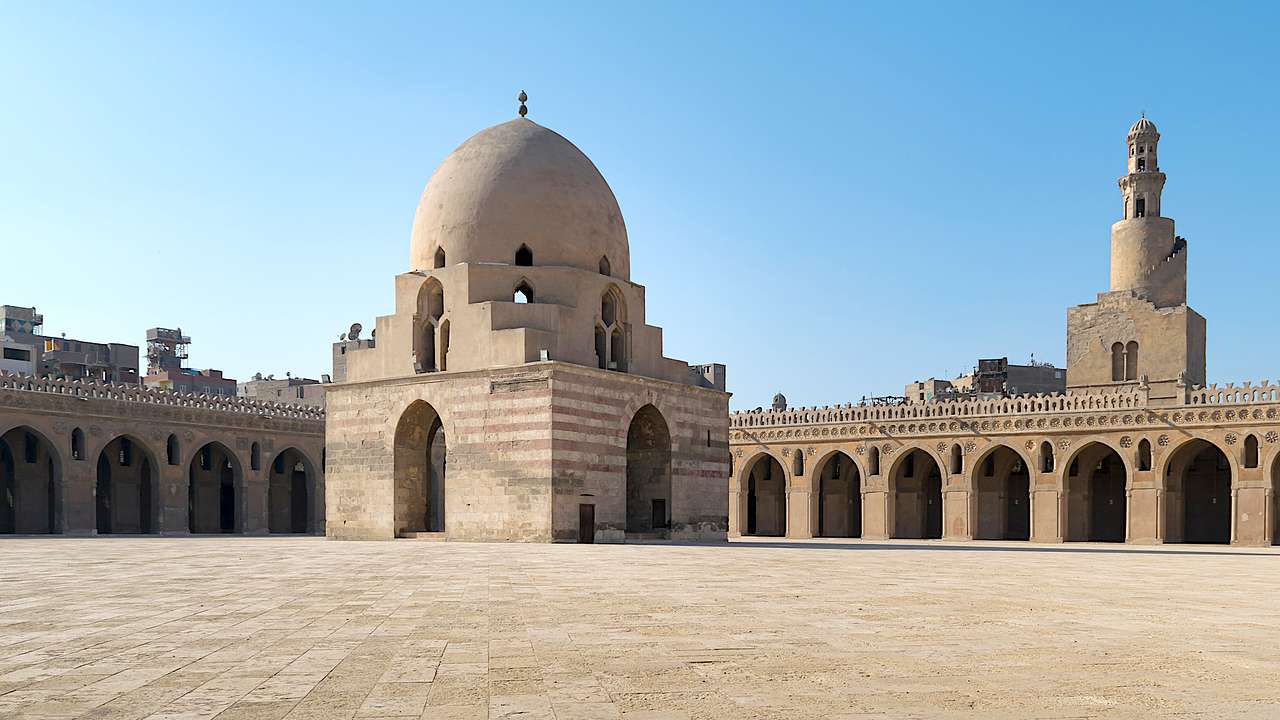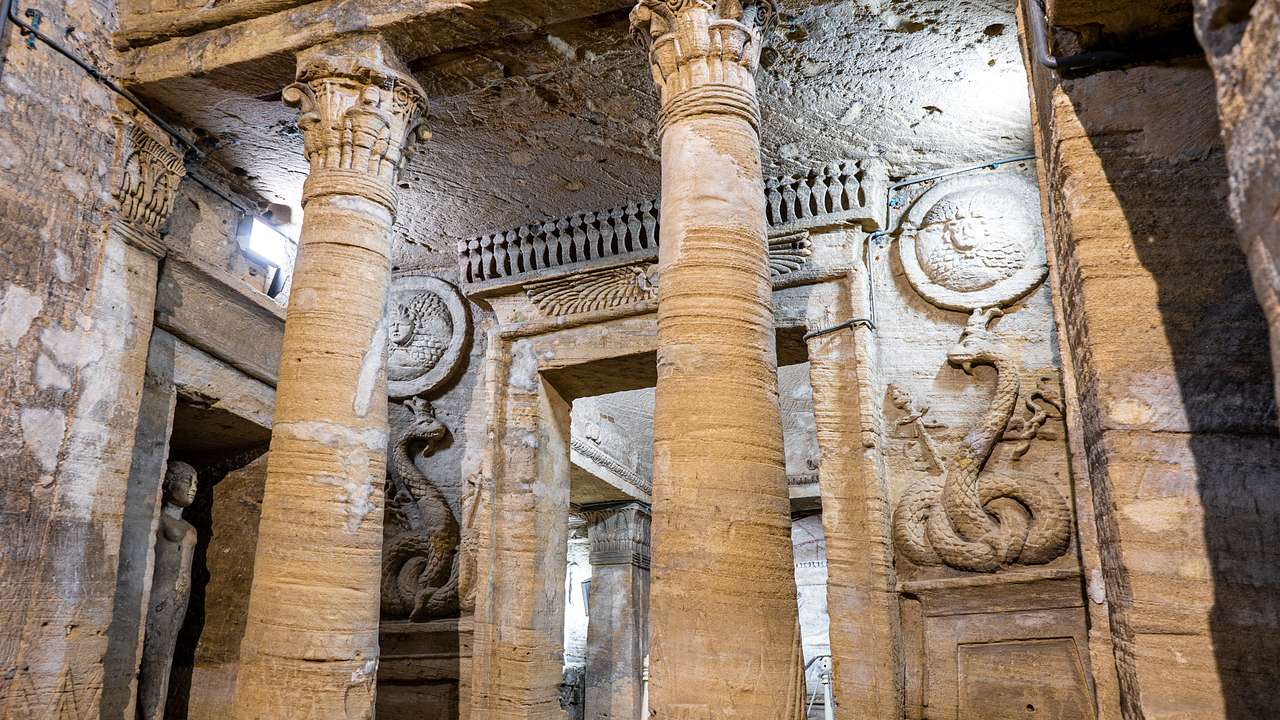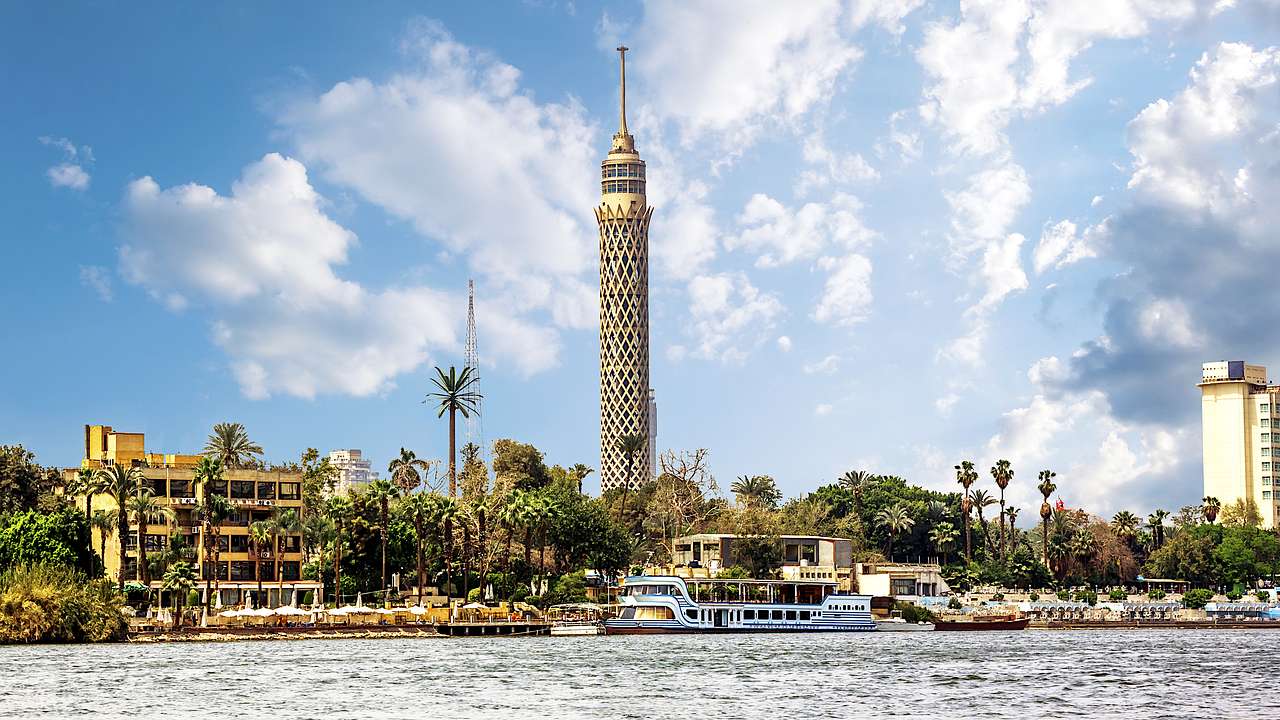Egypt Landmarks - 26 Famous Landmarks in Egypt to Explore
Destguides may receive commissions from purchases made through affiliate links in this article.
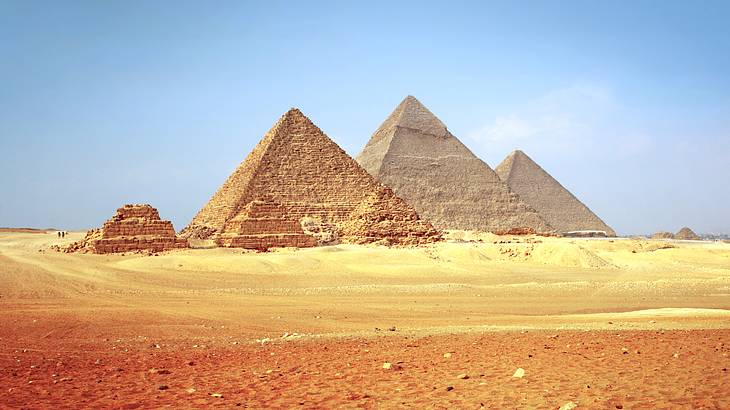
When it comes to travelling, the cost is one major factor that is always considered. Travelling to Egypt, depending on where you are travelling from, is considered to be quite affordable.
It is affordable because when you break down all the costs, vacations to Egypt are great value as you can fit quite a lot in for less. If you have a large budget, there are several luxurious options as well.
Egypt, a country in Africa that also links to the Middle East, is home to Pharaohs, dazzling monuments and stunning Egypt landmarks.
There are many famous landmarks in Egypt to explore and fun activities for visitors to do. You can go site seeing, take a stroll, go diving, and other activities based on your preferences.
If you are planning to travel to Egypt for any reason, especially for a vacation, then this is the guide for you. You can include these African landmarks on your own personal list. I hope this guide helps you plan your visit to Egypt!
Are you on your way to Egypt last-minute?
To make the most of your visit to Egypt, we recommend you book entrance tickets and tours soon. We've pulled together top suggestions below.
☂️ Top tours and experiences in Egypt
- From Hurghada - Luxor Valley of the Kings Full-Day Trip (likely to sell out)
- Sharm el Sheikh - Day Sail to White Island & Ras Mohamed (likely to sell out)
- Siwa Oasis all Inclusive Three Days Tour From Cairo or Giza (rated highly)
- Eight-Hour Private Tour of the Pyramids, Egyptian Museum & Bazaar From Cairo (very popular)
- Private All Inclusive - Giza Pyramids, Sphinx, Memphis, Saqqara, Lunch & Camels (very popular)
26 Famous Egyptian Landmarks
- The Egyptian Museum
- Giza Necropolis and Pyramids
- Mosque of Muhammad Ali
- Khan el-Khalili
- Abu Simbel Temples
- St. Catherine's Monastery
- Valley of the Kings
- Citadel of Qaitbay
- Temple of Seti I
- Temple of Philae
- Saqqara Necropolis
- Luxor Temple
- Montaza Palace and Royal Gardens
- The Temple of Karnak
- Great Sphinx of Giza
- Dendera Temple to Hathor
- Nubian Museum
- Bibliotheca Alexandrina
- Serapeum and Pompey's Pillar
- Al-Azhar Park
- Mortuary Temple of Hatshepsut
- Mortuary Temple of Amenhotep III
- Temple of Kom Ombo (Kom Ombo Temple)
- Mosque of Ibn Tulun
- Catacombs of Kom El Shoqafa
- Cairo Tower
Egypt Landmarks Video
Check out our highlights video of Egypt landmarks.
Egypt Landmarks Map
A map of Egypt landmarks. Use the map to explore all of the points of interest.
The Egyptian Museum
The Egyptian Museum is a must-visit, especially considering it is one of the top things to do when in Cairo. The museum is also the oldest archaeological museum in the Middle East.
The Egyptian Museum was opened in 1902 to house the antiquities of Ancient Egypt. Across the museum's two floors, you will find a collection of exhibits on Egypt's archaeological history.
The Egyptian Museum is the home of over 120,000 artefacts in total, including the contents of Tutankhamen's tomb, and mummies discovered since the 19th century.
When on the ground floor, you will be able to discover artefacts that educate you on Egypt's history from the Old Kingdom to the Greco-Roman period. On the top floor, most of the area is used to exhibit the interesting and renowned contents of Tutankhamun's tomb.
Other well-known artefacts on display include the burial masks of Yuya and Thuya and the Narmer Palette which contains some of the first hieroglyphic inscriptions ever found.
☂️ See The Egyptian Museum in Cairo on a tour
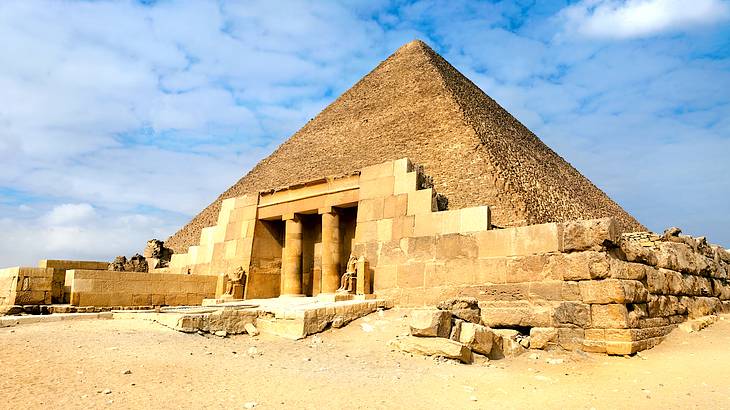
Giza Necropolis and Pyramids
The major attraction of the Giza Necropolis is the Giza Pyramids. With their incredible size and iconic design, the pyramids remain one of Egypt's significant landmarks. The Pyramids of Giza draw in millions of visitors to the country each year and cannot be missed while visiting Egypt.
This location also holds a lot of mystery. Many visitors (and Egyptologists) are still trying to understand how the three kings, Khufu and Khafra, could construct these vast structures during their reigns.
All three of the main pyramids, along with the smaller ones surrounding them, were built during the fourth dynasty of Ancient Egypt's Old Kingdom. The Old Kingdom is the first era of the three significant periods of Ancient Egypt.
The Pyramids of Giza were constructed using blocks of limestone, and surprisingly they have survived the elements of nature better than other pyramids. The oldest of the three is the Great Pyramid of Giza, which is additionally one of the Seven Wonders of the Ancient World.
Visiting the Giza Necropolis should be included on your Egypt itinerary if you are interested in historical Egyptian landmarks or want to snap some pictures with these iconic structures!
You can even book accommodation in Al-Haram. This is one of the best places to stay in Cairo if you want to wake up to views of the Pyramids!
☂️ Visit Giza Necropolis with an excursion
- Tour to Giza Pyramids & The Sphinx (frequently earns a five-star rating)
- Top Attractions Tour in Giza Pyramids & Horse Carriage With Panoramic View
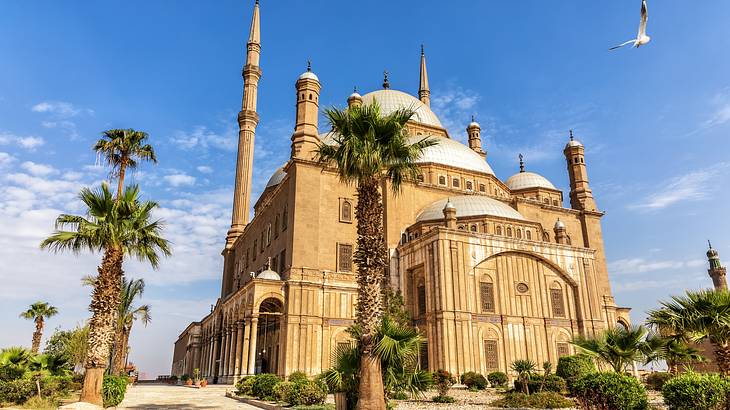
Mosque of Muhammad Ali
Even though the Mosque of Muhammad Ali is not really part of the ancient world or historic, it is still one of the most popular Islamic mosques to visit among tourists.
The Mosque of Muhammad Ali is located in the Citadel of Cairo, Egypt. The mosque is usually referred to as the Alabaster Mosque because of the use of alabaster stones in its construction.
It was built between 1830 and 1848 in memory of Muhammad Ali's son Tusun Pasha, who died in 1816. This long construction time allowed the architects to build a significantly large and intricately detailed building.
The structure of the mosque is imposing, especially when you are viewing it from a distance. One thing contributing to its popularity and prestige is its prominent location.
Along with being a tourist attraction, Egyptians consider the mosque to be a major landmark of Egypt. Since most Egyptians are Muslims, the mosque is cherished by local Egyptians and those that come from farther to visit.
☂️ Explore the Mosque of Muhammad Ali on a tour
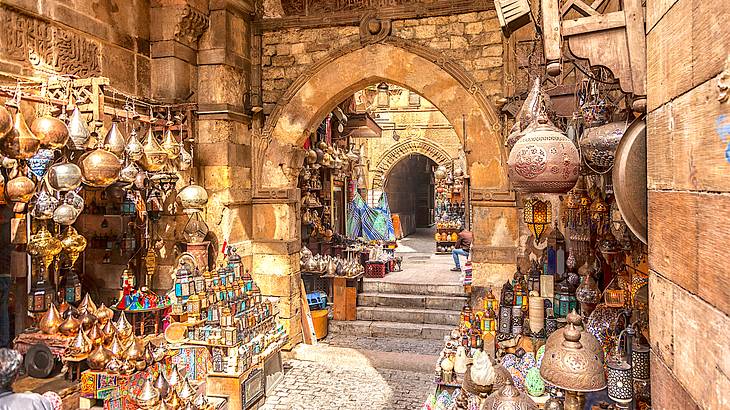
Khan el-Khalili
Visiting Cairo without making a stop at the Khan el-Khalili is almost impossible. Khan el-Khalili is a popular bazaar established in the 14th century and is located in the centre of Islamic Cairo.
The bazaar still has a strong medieval feel and will take you back in time. The main attraction here is the various stalls that sell a range of items from souvenirs to decor items, antiques, and spices.
The bazaar is the perfect place to explore if you are looking for some very unique items to remember your trip by or gift to friends and family.
There are additionally several cultural and historic sites in Khan El-Khalili, so it is no surprise that it attracts so many visitors. This includes the Al-Hussein Mosque as well as El-Fishawi cafe, the oldest cafe in Cairo that has been open since 1797.
I also highly recommend visiting Khan el-Khalili during the Mawlid Al-Hussein celebrations. The Mawlid Al-Hussein celebrations are a Sufi celebration of the birth of the Prophet Muhammad's grandson.
Sufists perform litanies and other traditional activities during this time. If you are a Muslim, you get the opportunity to learn more about your culture at these events too. Besides that, if you are of a different religion, you can appreciate these festivities and learn more about Muslim culture and traditions.
☂️ Explore Khan el-Khalili with a tour
- All Inclusive Trip Giza Pyramids,Egyptian Museum,Sphinx,Bazar,Camel Ride,Lunch (a sort after tour)
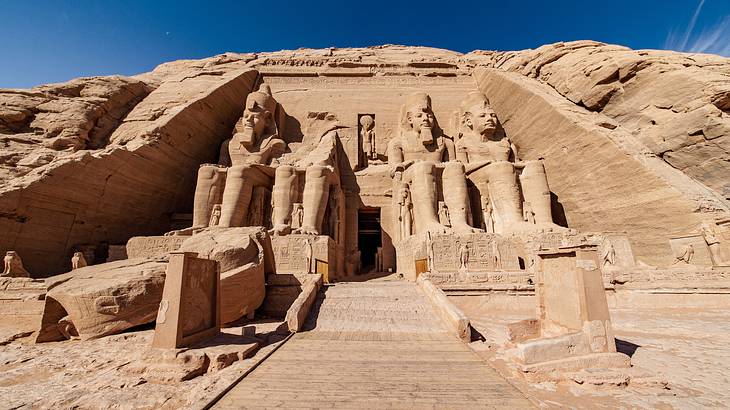
Abu Simbel Temples
The Abu Simbel Temples are some of Egypt's most famous landmarks and are also a UNESCO World Heritage site as one of the Nubian Monuments. This temple complex features two stone cut temples, one of which is dedicated to Pharaoh Ramesses II and the other to his wife Queen Nefertari.
The temples, built in the 13th century BC, were initially located on the Nile River's west bank and stood there for about 3,000 years. However, the temples were later dismantled and rebuilt on a higher hill in Abu Simbel in the 1960s.
Getting to the Abu Simbel Temples requires a four-hour car ride from Cairo, however many companies run private transfers or buses. If you are willing to pay more, you can also take a plane. Several companies offer day trips from either Cairo or Aswan.
☂️ Visit Abu Simbel Temples with an experience
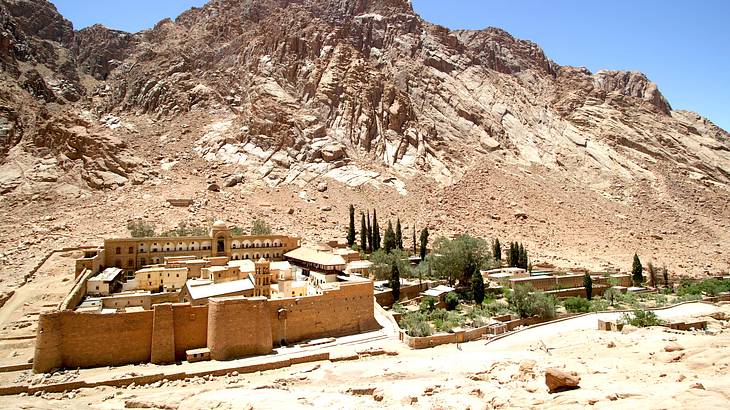
St. Catherine's Monastery
St. Catherine's Monastery, or the Sacred Monastery of the God-Trodden Mount Sinai, is one of the world's oldest monasteries and is still actively used today. It is believed that the burning bush recorded in the old testament of the Bible is enshrined in the monastery.
The monastery has been the home of many monks since its construction in mid-500 AD, using Mount Sinai as their protection from the outside world.
This should not come as a surprise, but inside St Catherine's Monastery is the Chapel of the Burning Bush. It is a small chamber found behind the altar, but unfortunately, it is often closed to the public.
If you are fortunate and it is open when you visit, you have to take off your footwear before entering the chamber. This is to show the respect you have for God in a holy place. The monastery is one of the best places for you to learn about Christianity, not just in Egypt but in the world.
☂️ Explore Saint Catherines Monastery with a tour
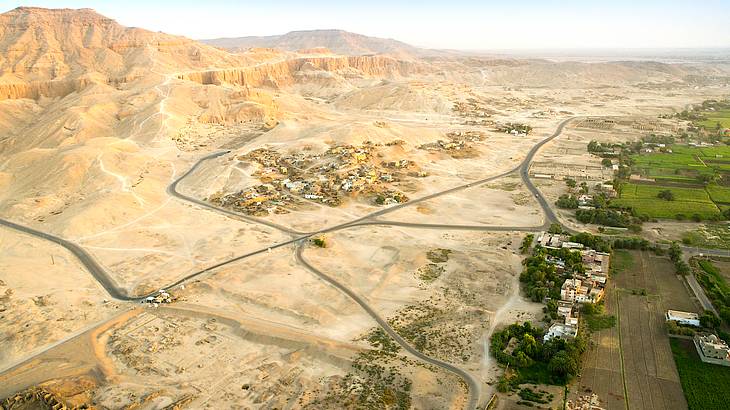
Valley of the Kings
The Valley of the Kings is another one of the major landmarks in Egypt and is known worldwide for its royal tombs. This popular landmark is listed as a UNESCO World Heritage Site and features tombs built between 1539 and 1075 BC.
The Valley of the Kings is located in a desert valley in Luxor. The tombs were constructed as the burial ground for Egyptian Pharaohs from the 18th, 19th, and 20th dynasties. Some of the Pharaohs buried here include Tutankhamun, Tuthmose III, and Seti I.
In all, you can find about 62 tombs in the Valley of the Kings. In the past, exploring the tombs was more dangerous since they were mostly undiscovered. However, today the tombs are well-lit and well-marked. This makes it easy for tourists to discover these tombs allowing for a very memorable experience.
☂️ Visit the Valley of the Kings with a tour
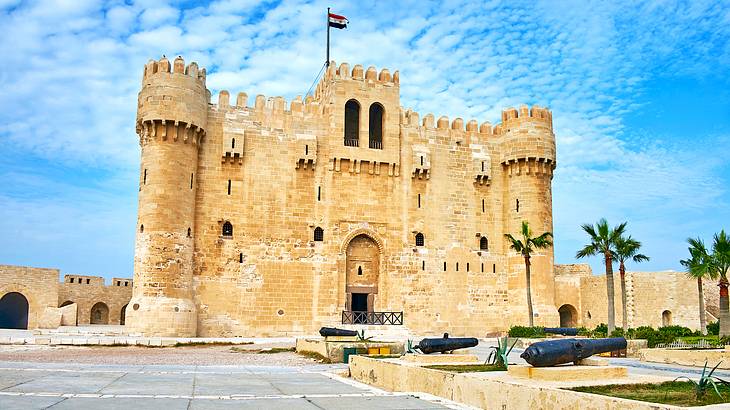
Citadel of Qaitbay
Another famous Egyptian landmark is the Citadel of Qaitbay, also known as Fort Qaitbey. You can locate the Citadel on the Island of Pharos, west of Alexandria city.
The impressive structure was built on the same location as an old lighthouse after it was destroyed by an earthquake, and was named after the sultan Ashraf. The sultan at that time wanted to protect Alexandria city from the direct threats of the Ottoman Empire.
The citadel's first floor contains a mosque and a defence hall, allowing soldiers to easily defend the citadel when it is under attack. The second floor includes the chambers and halls.
On the third floor, you can find the throne chamber of the sultan. Visiting the Citadel of Qaitbay gives you an idea of how sultan Ashraf lived while trying to protect Alexandria.
☂️ See the Citadel of Qaitbay on a tour
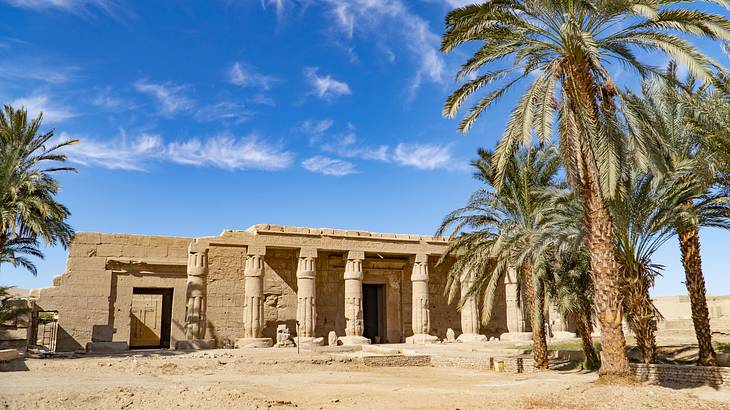
Temple of Seti I
Seti I is known to be one of the less popular pharaohs to have ruled during Egypt's New Kingdom era. One surprising thing is his son Ramesses II went on to become one of the most well-known pharaohs in the country.
Even though he is not one of Egypt's famous pharaohs, his temple has become one of the most well-known temples in the country.
The temple, located in Luxor and built in 1279 BC, is a limestone L-shaped structure instead of the typical rectangular shape. Many people who travel to Egypt claim that the temple is one of the most impressive religious structures in existence.
The temple has several features that attract visitors, including the interior's beautifully decorated walls and murals and the exterior's vast and peaceful grounds.
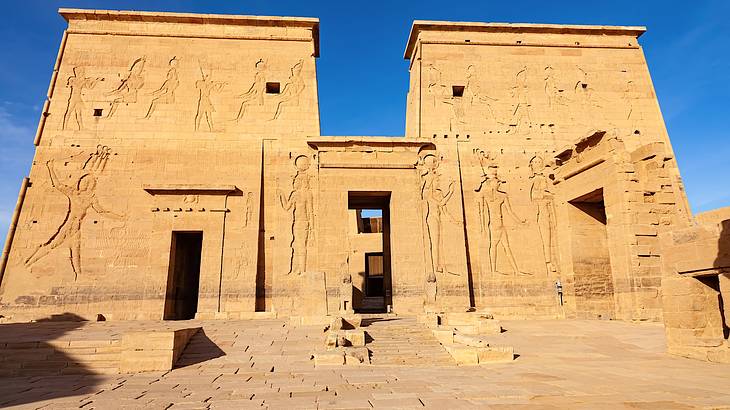
Temple of Philae
The sacred site of Philae is one of the tourist attractions in Egypt that attracts many travellers every year. It is a small island located in Aswan, mainly popular because of the Temple of Philae, also known as the Temple of Isis.
The Temple of Isis was constructed in 280 BCE by Ptolemy II. It is dedicated primarily to the goddess Isis as well as to the gods Horus and Osiris.
This is made clear in the temple's design with its walls being covered in stunning illustrations from Egyptian mythology. For example, one illustration shows the goddess Isis bringing Osiris back from the dead.
The temple survived destruction when the Aswan dam was built during the 1960s. With both the Egyptian government and UNESCO coordinating to ensure that the temple was rescued. The rescue effort took about ten years to complete.
It is of no surprise that the temple attracts visitors year on year due to its history and beauty.
☂️ Visit Philae with a tour
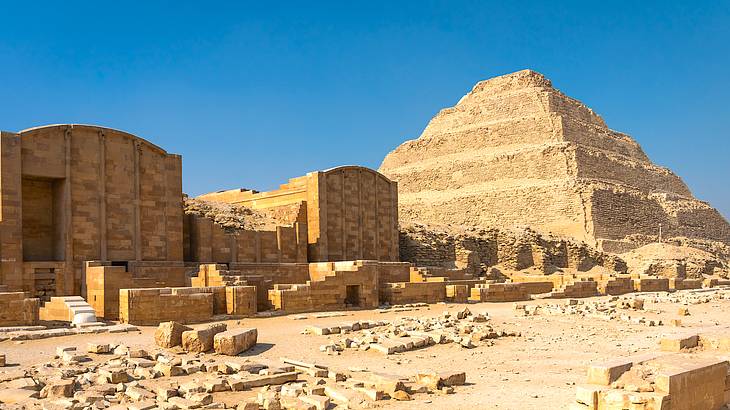
Saqqara Necropolis
When it comes to Egyptian pyramids, many people think only of the Pyramids of Giza. However, these are not the only famous pyramids in Egypt. Another group of pyramids called the Saqqara Necropolis 30-kilometres north of Cairo, the country's capital.
The vast Saqqara burial grounds cover an area of about seven by one and a half kilometres. For those who love history, taking a day trip to the Saqqara Necropolis while visiting Cairo should be on your list.
The area features a vast number of pyramids and underground tombs for you to visit. One of the most popular pyramids found here is the Step Pyramid of Djoser. The Step Pyramid is the oldest tomb found in the Saqqara Necropolis having been built during the Third Dynasty. Other renowned landmarks here include the Pyramid of Unas and Mastaba of Ti.
What's noticeable is how strong and well-preserved these pyramids are after the thousands of years they have stood here. This in itself is one of the main reasons why the pyramids are a major attraction in Egypt and a must-visit for all tourists.
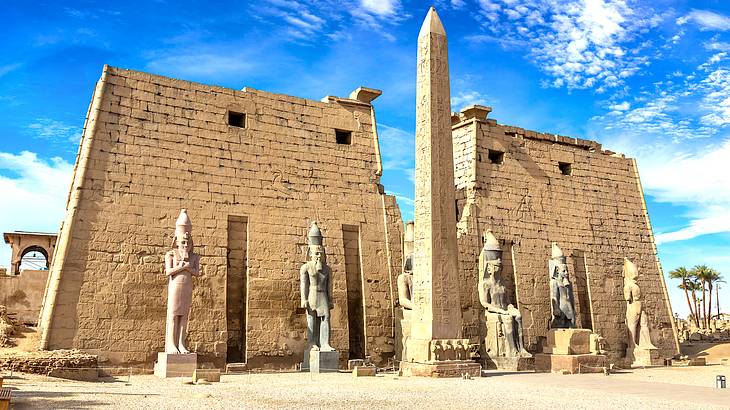
Luxor Temple
Luxor City in Egypt was the ancient state capital location during the 12th Dynasty from 1991 BC to 1783 BC. The city is now home to many ruins and temples. This includes one of the most beautiful temples in Egypt, the Luxor Temple.
The Luxor Temple is a mark of Ancient Egyptian civilisation and today stands as a strikingly graceful monument in the heart of modern Luxor. Luxor Temple was constructed in 1400 BCE during the New Kingdom, using sandstone as the primary building material.
Pharaoh Amenhotep III began construction, but other pharaohs, including Tutankhamun and Rameses II added to the design as well. Unlike other temples found in Luxor, the Luxor temple was built to rejuvenate kingship instead of for one specific god or pharaoh. Due to this, many kings have been crowned at the Luxor Temple.
It was also constructed to be the place to celebrate the Opet Festival. This festival was honoured to provide energy to the gods who the Ancient Egyptians believed grew tired as the year progressed.
I recommend you go around sunrise or sunset if you want to visit the temple. During sunset, in particular, the evening sky makes the environment perfect for a photo opportunity.
☂️ Experience Luxor Temple with a tour
- Full Day Tour to East & West Banks of Luxor (popular and sought-after)
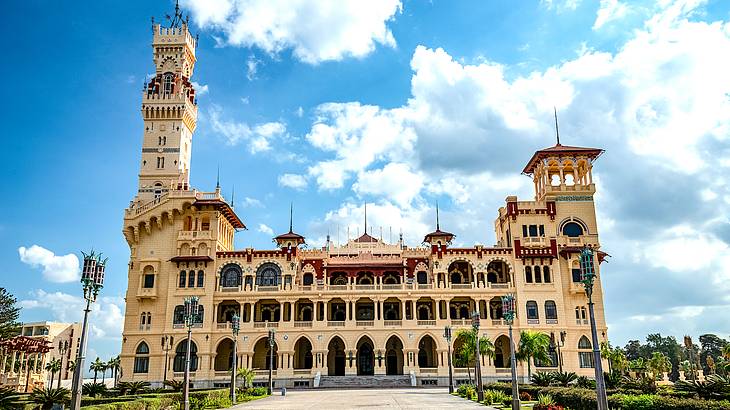
Montaza Palace and Royal Gardens
Khedive Abbas II built the Montaza Palace and Royal Gardens at the beginning of the 20th century. Khedive was a relative of King Farouk, the ruler of Egypt at that time.
The palace features a combination of Turkish and Florentine architectural styles creating a beautiful European-style structure. It is found in Alexandria, right on the coast within walking distance of the beach.
The Montaza Palace complex contains an extensive museum and breathtakingly beautiful royal gardens that overlook the Mediterranean Sea. The gardens alone cover around 3,000 metres and are filled with perfectly manicured lawns, trees, and plants.
The gardens are open to the public, and I highly recommend exploring the area if you have the time. Visiting these royal grounds is an extremely relaxing and fun thing to do in Egypt!
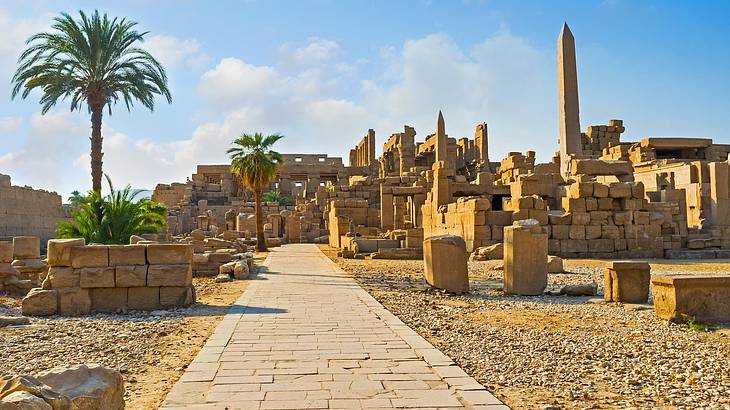
The Temple of Karnak
The Karnak Temple (also known simply as Karnak) is one of Egypt's most famous attractions. It is a massive temple complex located on the east bank of the Nile River in Luxor. Karnak additionally acts as one of the Unesco World Heritage sites named Ancient Thebes with its Necropolis.
The temple covers a ground area of 100 hectares, which is bigger than some ancient Egyptian cities! Construction of the temple took close to 2,000 years to fully complete with dozens of pharaohs adding to the design over that time.
The Temple of Karnak is undoubtedly the biggest temple complex in Egypt. The immense size of the temple alone makes it a historical landmark in Egypt. Wandering through the area will have you amazed at the towering columns, obelisks, and temple walls.
The main structure within the complex is the Temple of Amun. This temple attracts many visitors as it is the largest place of worship to have been built in the area.
It will take at least a day to explore the entire complex, possibly more. So if you plan to visit, be sure to set aside at least one day in your schedule to do so.
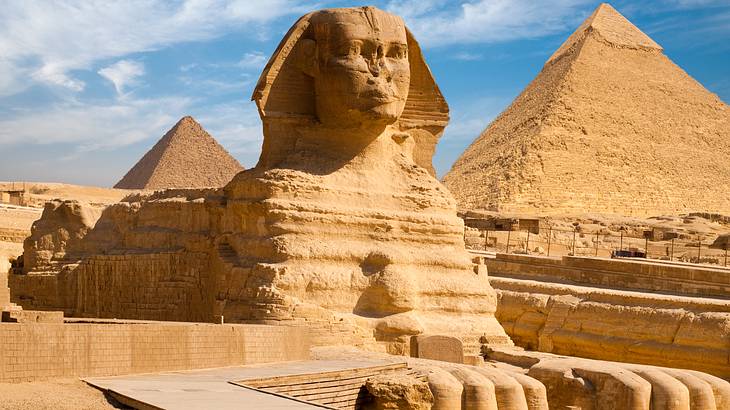
Great Sphinx of Giza
When you are looking for a monument that optimises Egypt's Old Kingdom, you cannot overlook the Sphinx of Giza. The Sphinx of Giza is the oldest stone (specifically limestone) built sculpture in the Old Kingdom.
In addition to this, the Great Sphinx is one of the most well-recognized Egyptian landmarks across the globe. Visiting it is a "bucket-list" item for many travellers.
The Sphinx of Giza was called "Horus of the Necropolis" during the 18th dynasty, which means the "sun god that stands above the horizon". The monument stands at almost 70 feet high and is 240 feet long.
Many believe that the face of the Sphinx is that of the Chephren (Khafra), the pharaoh who constructed the second-largest pyramid in the Giza triad.
Over the years, the sculpture has gone through lots of challenges. For example, the Sphinx monument is missing its nose, how the nose went missing is a mystery and was not recorded in the monument's history.
Today the Great Sphinx of Giza is extensively preserved and protected from damage. Due to these efforts, visitors are not allowed to get too close. However, this does not mean you cannot view it from a distance. The Sphinx's large size means that you can still thoroughly appreciate it (and get great photos) from afar.
☂️ Experience the Great Sphinx of Giza with a tour
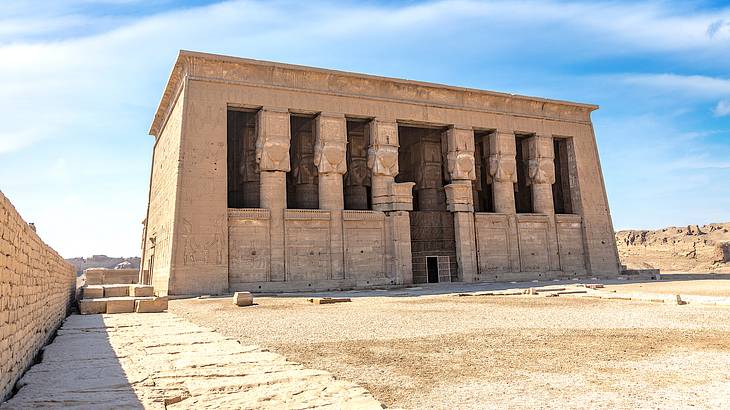
Dendera Temple to Hathor
Dendera Temple is another famous landmark in Egypt and one of the most popular attractions in Luxor. It is one of the most well-preserved temple complexes in the country and the world at large.
The temple complex was built in the 1st century BC by Ptolemy 8th and Queen Cleopatra, the last ruler of the Ptolemaic Kingdom of Egypt. The temple complex contains a basilica, a sacred lake, two birth houses, a sanatorium (effectively an ancient spa), and other temples and shrines. The whole complex covers about 40,000 square metres and is surrounded by a mudbrick wall.
When you enter the main temple, you will get the opportunity to witness the exquisite design elements inside. This includes highly detailed astrological calendars that are painted and carved on the temple ceilings. There are also intricate hieroglyphic walls found throughout the temple.
Another unique feature of the Dendera Temple is the mysterious crypt found underground and enclosed within the upper temple's double walls.
☂️ Explore Dendera Temple to Hathor with a tour
Nubian Museum
Nubia is a region located between Aswan and Egypt's border with Sudan. It is believed that Nubia was derived from the word "Nebo" which means "mines of gold." This is most likely what made the region famous in the distant past with miners and others travelling to discover gold deposits.
The location today is more well-known for housing the Nubian Museum. This museum was built in 1997 to serve as a reminder of what the people of Nubia lost beneath Lake Nasser.
The museum features exhibits on history, art, and culture from the Nubian era and the Pharaonic, Coptic, Islamic eras. The museum exhibits range from those displaying prehistoric artefacts from the Kingdom of Kush to those showing more recently discovered artefacts.
One highlight of the museum is the 6,000-year-old painted bowls that still feature their intricate designs. However, with over 3,000 ancient Egyptian antiquities kept here, there are many more artefacts to discover that show you the city's history.
Bibliotheca Alexandrina
Bibliotheca Alexandrina (Library of Alexandria) is one of the largest and most important libraries globally and one of the most famous places in Egypt. The library is found alongside Alexandria's ancient harbour.
Built in a contemporary architectural style, the library was inaugurated in 2002. It is 11 stories high and has a distinctive cylindrical design. The library was created to commemorate the ancient Library of Alexandria that was burned down in 48 BC by Julius Caesar.
It is estimated that the main library is capable of holding more than eight million books. There is additionally a grand reading room where you can relax and study various literary items.
While you may think that you will simply find shelves of books inside, the library features much more. This includes a planetarium and other impressive collections along with the vast array of books.
There are also four museums including an Antiquities Museum and a Manuscript Museum featuring a fantastic collection of ancient texts and scrolls.
The library serves as a place of inspiration and is a great location to learn more about ancient and modern Egypt in a very relaxed and academic atmosphere.
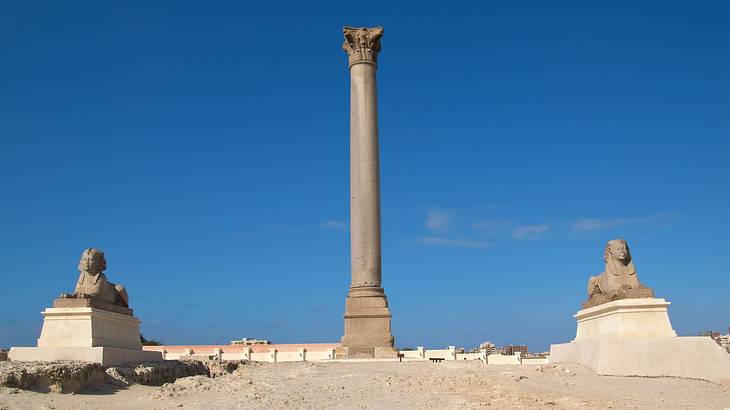
Serapeum and Pompey's Pillar
Pompey's Pillar is a single column Roman pillar and is the largest of its kind found outside of Greece. The pillar can be located on a rocky hill in Alexandria, Egypt.
Even though the pillar is named Pompey, it has no relation to General Gaius Pompey. The pillar is 67 feet high with a diameter of about eight feet at its base. It was built around 298 AD in honour of Diocletian a Roman emperor.
Despite being built for Diocletian, many crusaders believed that the ashes of the Roman general Pompey were kept in a pot on top of the column during the middle ages. Today, the pillar serves as a site to mark the spot that once held the Temple of Serapeum.
When you are in Alexandria, you can take a taxi to the Pillar. Ask the driver to take you to Amoud Al Sawari, which is the same as Pompey's Pillar in Arabic.
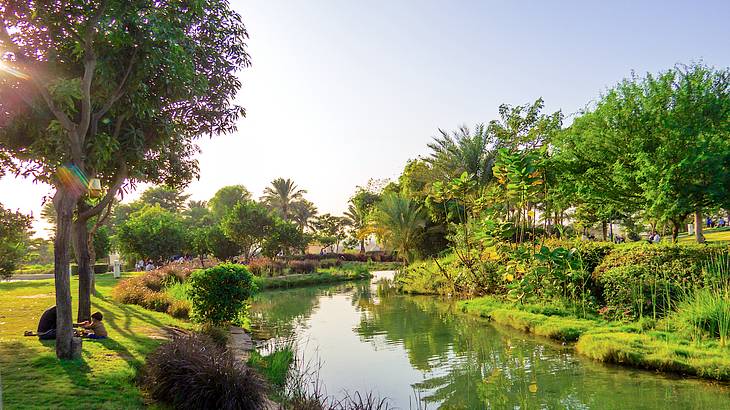
Al-Azhar Park
Al-Azhar Park is one of the most popular attractions in Egypt, drawing in several tourists each year. It is located on a hill surrounded by the many historical sites of Cairo. The park is notably included on the Project for Public Spaces' list of the World's Sixty Great Public Places.
Construction of Al-Azhar Park was initiated by his highness Aga Khan after viewing the desolate space that now holds the park from his hotel in 1984. He decided to donate the park to Cairo's people with the Islamic belief that everyone is a trustee to God's creation.
The 30-hectare urban park features multiple gardens and a vast array of lush trees and plants. There are also exciting details, such as arches and quaint bandstands placed throughout.
Al Azhar Park is one of the famous landmarks you must visit when you are in Cairo, Egypt. It offers incredible views and is the ideal place to relax and enjoy yourself. This is also a great place to take your family while you are in Cairo.
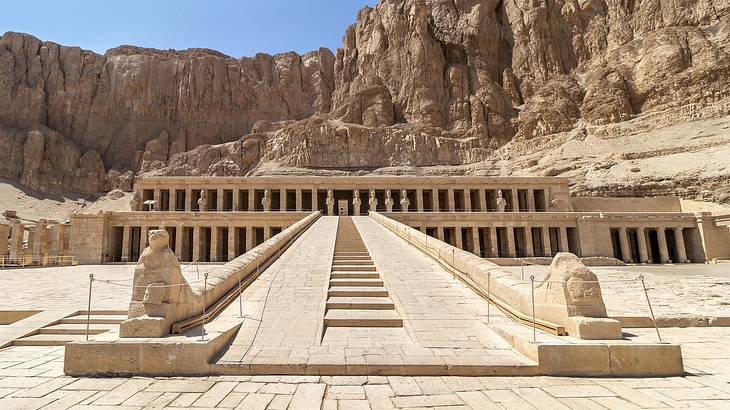
Mortuary Temple of Hatshepsut
Located in Luxor near the Valley of the Kings, the Mortuary Temple of Hatshepsut is dedicated to Egypt's longest female ruler, Queen Hatshepsut. This highly detailed temple features many statues and sphinxes throughout to bring good fortune to the Queen in the afterlife.
The stunning temple is carved into the surrounding mountains and looks even more impressive with these stone mountains rising above it. Including three storeys to explore, the temple resembles a Greek or Roman palace than the pyramid burial tombs of well-known Pharaohs.
Inside, you'll be able to explore the three levels filled with ancient artefacts and walls adorned with murals and hieroglyphics. While a less well-known landmark of ancient Egypt, this temple is a must-visit while in the area.
Mortuary Temple of Amenhotep III
The Mortuary Temple of Amenhotep III is located in Luxor on the western bank of the Nile. It is known for the Colossi of Memnon that sits at the entrance of the temple. These two statues of the Pharaoh Amenhotep III atop his throne guard the area and are the first thing visitors to the west bank will encounter.
Both at more than 60 feet tall, they are indeed a magnificent and imposing presence for travellers to see. The temple complex itself, including the statues, was built during the 18th dynasty as the resting place for Amenhotep III.
Unfortunately, much of the temple does not remain today. Both its close location to the Nile, which resulted in erosion occurring, and the effects of an earthquake in 27 BC have almost obliterated the structure.
The mortuary temple is more a site of ruins unlike many of Egypt's other burial temples which are still fully standing and open for the public to explore.
However, this is still a historically significant location where you can view the Colossi of Memnon and wander around what is left of the temple in the area it once stood.
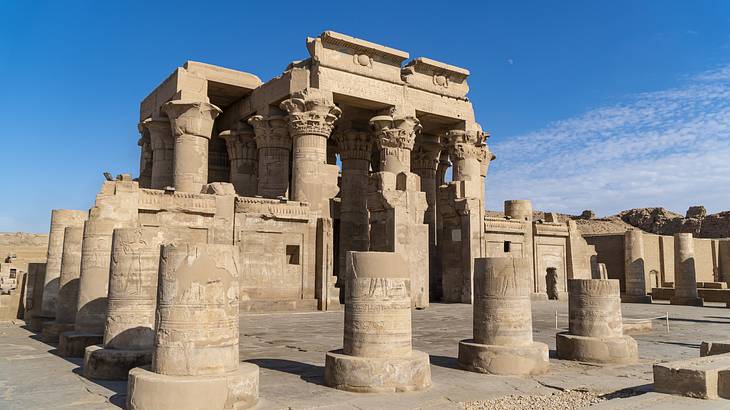
Temple of Kom Ombo (Kom Ombo Temple)
This site is another temple to be added to your list of ancient Egypt landmarks that you should visit. The Temple of Kom Ombo (or Kom Ombo Temple) is a unique double temple found in Kom Ombo which is in Aswan.
The temple is an awe-inspiring architecture piece designed in a Graeco-Roman style and constructed during the Ptolemaic Dynasty.
A central point of interest with this temple is its doubled design. The temple has sections that are effectively mirrored after each other and are dedicated to two different sets of gods. This symmetrical design is very unusual with temples usually solely dedicated to one god or one group of gods.
However, quite a bit of the structure has been worn away over the thousands of years since its construction. But many of the main pillars and walls do stand today. This means there is still lots for you to explore, allowing your imagination to make up for what is missing from the design.
☂️ Discover Kom Ombo Temple on a tour
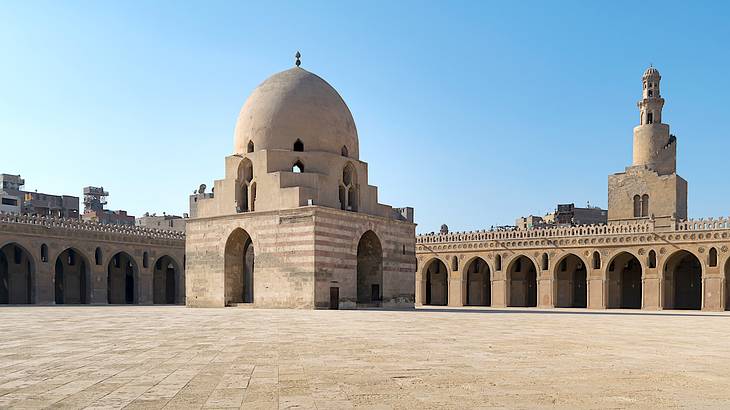
Mosque of Ibn Tulun
Cairo has multiple stunningly designed mosques, but this mosque is one of the most well-known and a must-visit. The Mosque of Ibn Tulun is the oldest mosque in Egypt and on the entire continent of Africa. It also happens to be the largest mosque in Cairo.
The mosque was built around 879 AD by Ahmad Ibn Tulun and is designed in a Samarran style. The vast building was constructed around a courtyard that houses a dome-topped fountain. The interior features many archways and carved details as well.
While the mosque is quite simple in design, it is a beautiful and relaxing place to visit. You can also pray if you are a practising Muslim as it is still a functioning mosque.
☂️ Explore the Mosque of Ibn Tulun with a tour
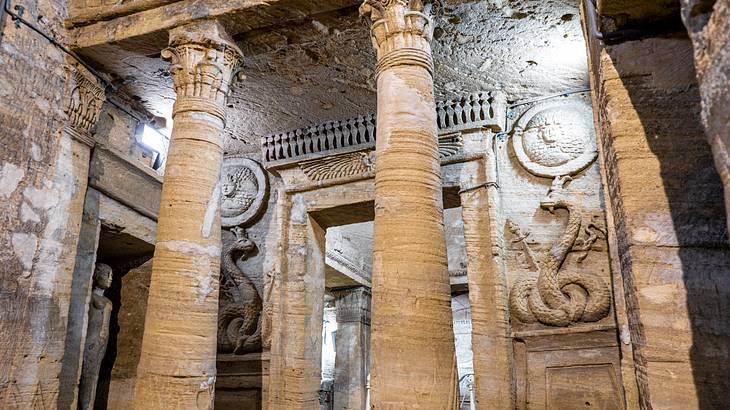
Catacombs of Kom El Shoqafa
Located in Alexandria, the Catacombs of Kom El Shoqafa are an ancient catacomb complex found close to Pompey's Pillar. The catacombs were constructed in the 2nd century AD by Antonine emperors and are one of the Seven Wonders of the Middle Ages.
The catacombs feature three levels, although only the top two are accessible today. Visitors will reach each level by following a spiral staircase down. The stairs wind parallel to a shaft through which bodies were lowered to be buried in their final resting place.
The first level features an open funeral hall space. This is where relatives and acquaintances would come to see the body lowered and pay respects. This level also houses the Hall of Caracalla, where bones of both humans and horses have been discovered.
The second floor is where most of the bodies were interred. Here, you can see sarcophagi and statues of various gods, including Anubis, the god of the dead. This level features a complex system of tunnels, all of which hold the bodies of those buried here.
This landmark is an eerie but beautiful space in which you can appreciate the pageantry of ancient burial. You will be able to view first hand the thought that went into paying respects to the dead and ensuring they would be prosperous in the afterlife. It is well worth a visit as long as you are comfortable with small enclosed spaces!
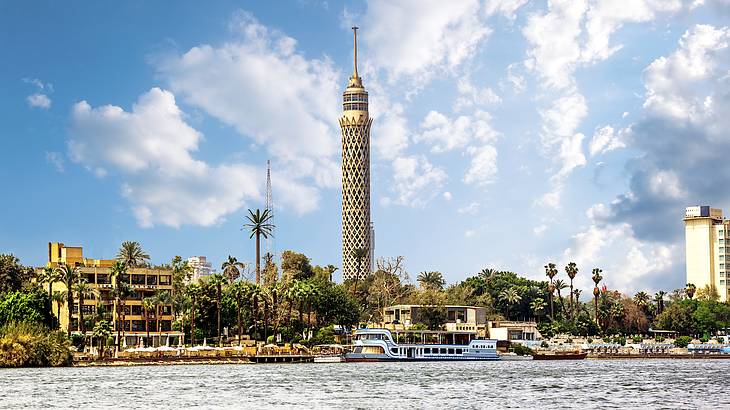
Cairo Tower
The Cairo Tower is one of the most modern famous Egypt landmarks. Having explored the various places of significance from ancient Egypt, visiting Cairo Tower is a great way to view Cairo as it is today from up high.
This viewing tower stands at 187 metres high and is the tallest structure in Egypt and North Africa. The building is designed in a contemporary style that stands out amongst the city's older structures and resembles a lotus plant.
A trip to the viewing deck will offer amazing 360-degree views of the city. From here you can see the Pyramids of Giza, Sakkara, the Citadel, and more. The addition of telescopes allows you to see further and in even more detail.
The tower additionally features a revolving bar and restaurant serving high-end cocktails and oriental dishes.
☂️ Visit Cairo Tower with a tour
In Conclusion
There is no lack of famous Egyptian landmarks for you to visit if you plan to travel to the country.
Most of these landmarks are ancient, built in the time of the Pharaohs and Egyptian dynasties. Therefore, visiting allows you to see how these stunning temples, pyramids, and other structures have survived over thousands of years.
With so many iconic landmarks to check out, it can be challenging to know what needs to be top of your list. Hopefully, this 26 Famous Landmarks in Egypt itinerary will significantly help you plan your visit to this beautiful country!
Want to keep exploring?
Subscribe for discounts on tickets and hotels and our latest guides.
Thank you for subscribing
We will be in touch soon with discounts on tickets and hotels and our latest guides.
Want to keep exploring?
Subscribe for discounts on tickets and hotels and our latest guides.
Thank you for subscribing
We will be in touch soon with discounts on tickets and hotels and our latest guides.

